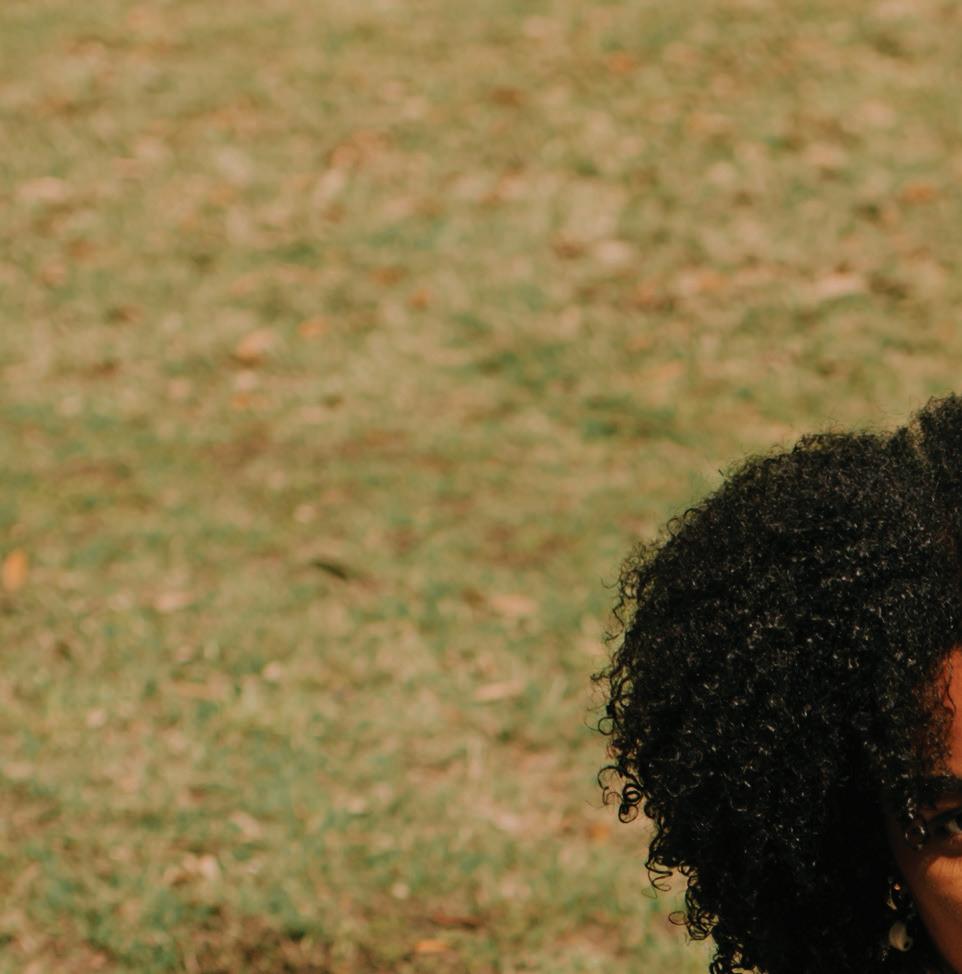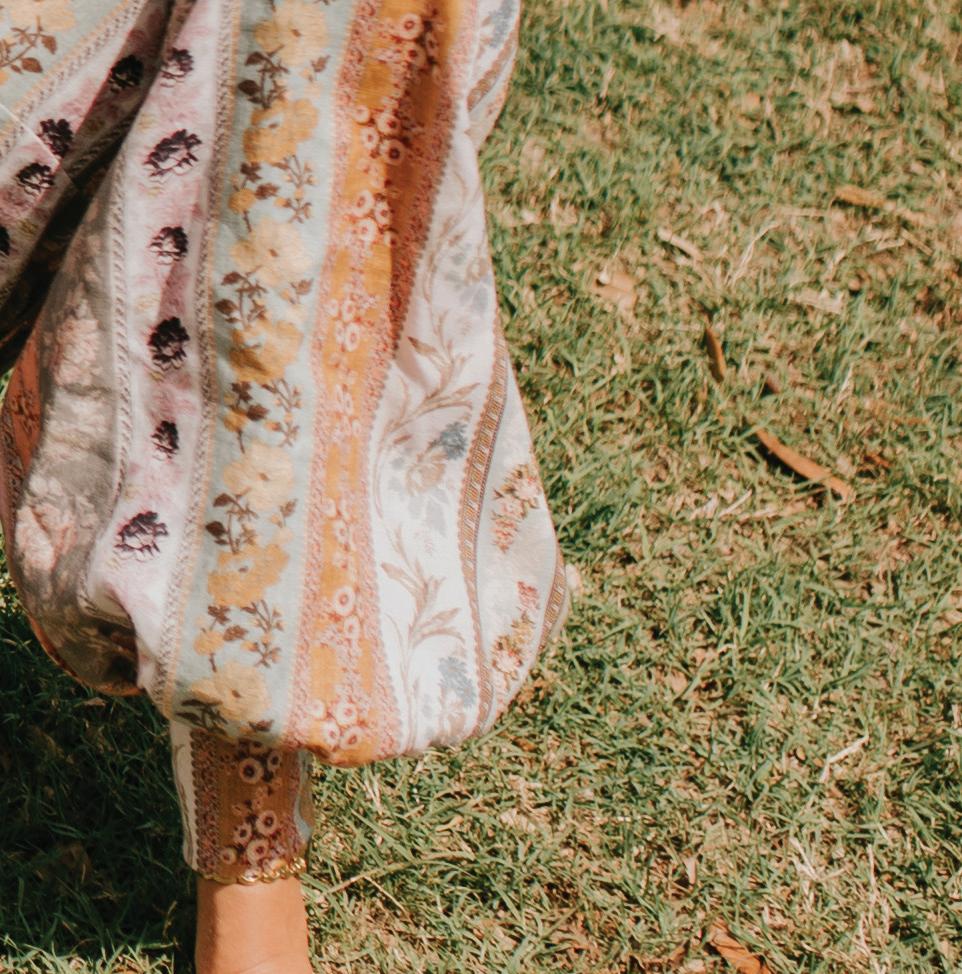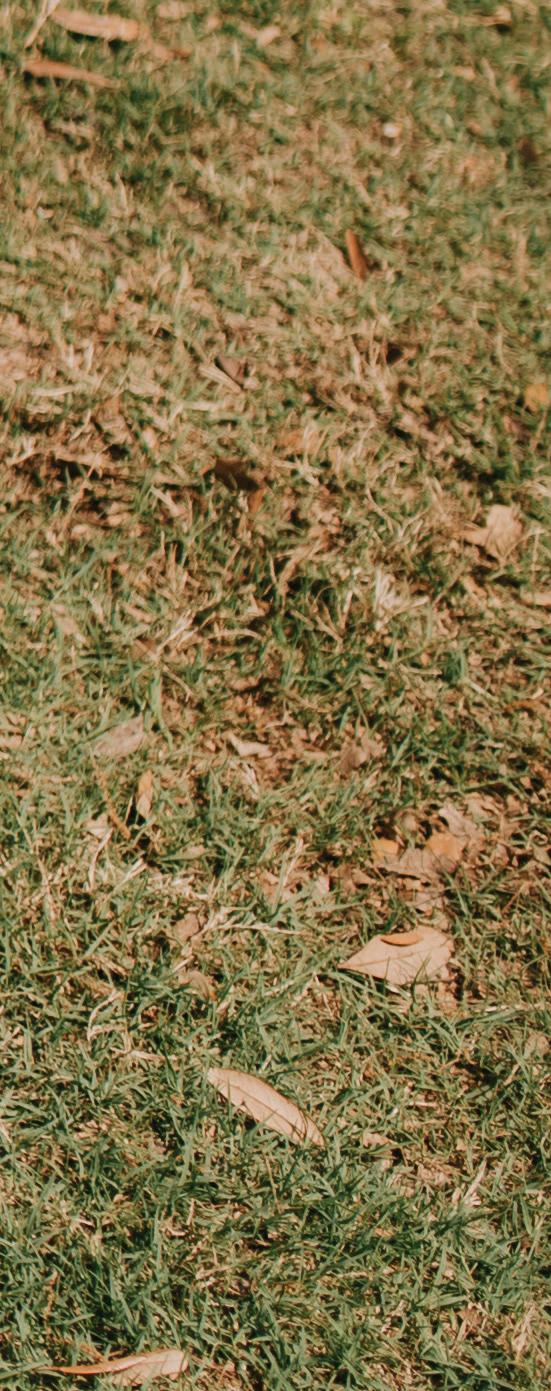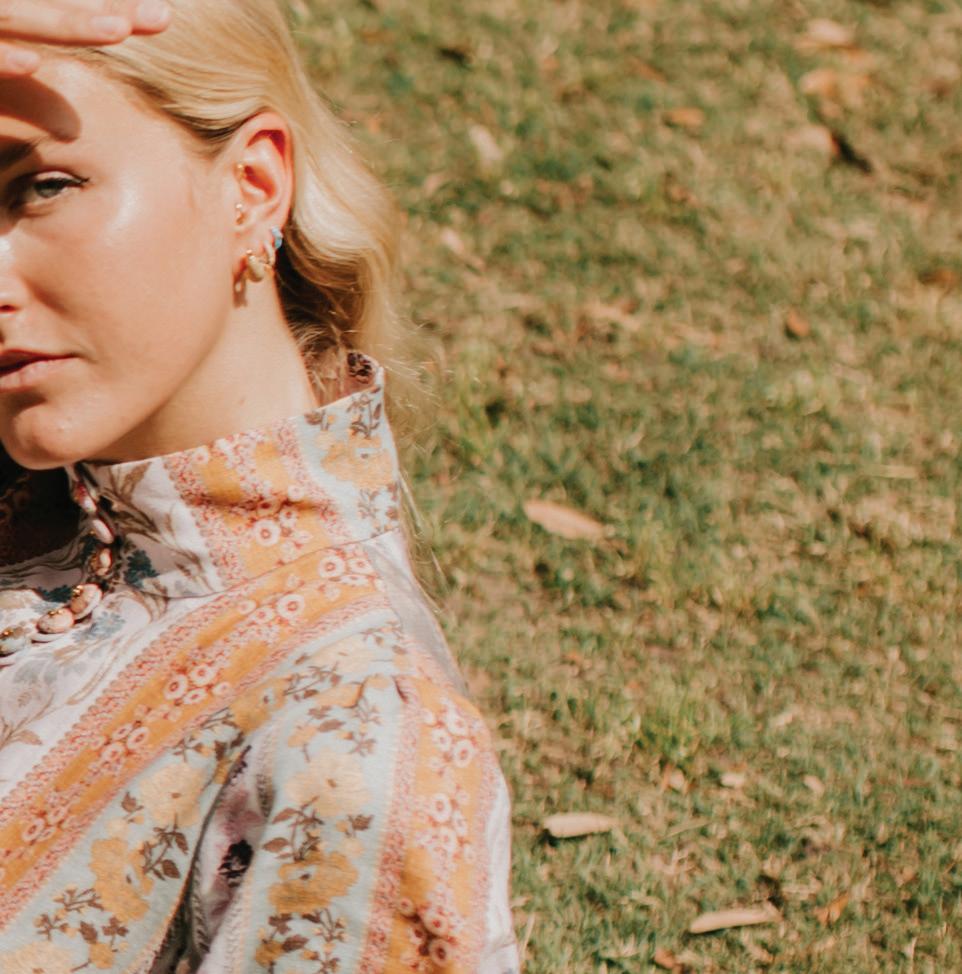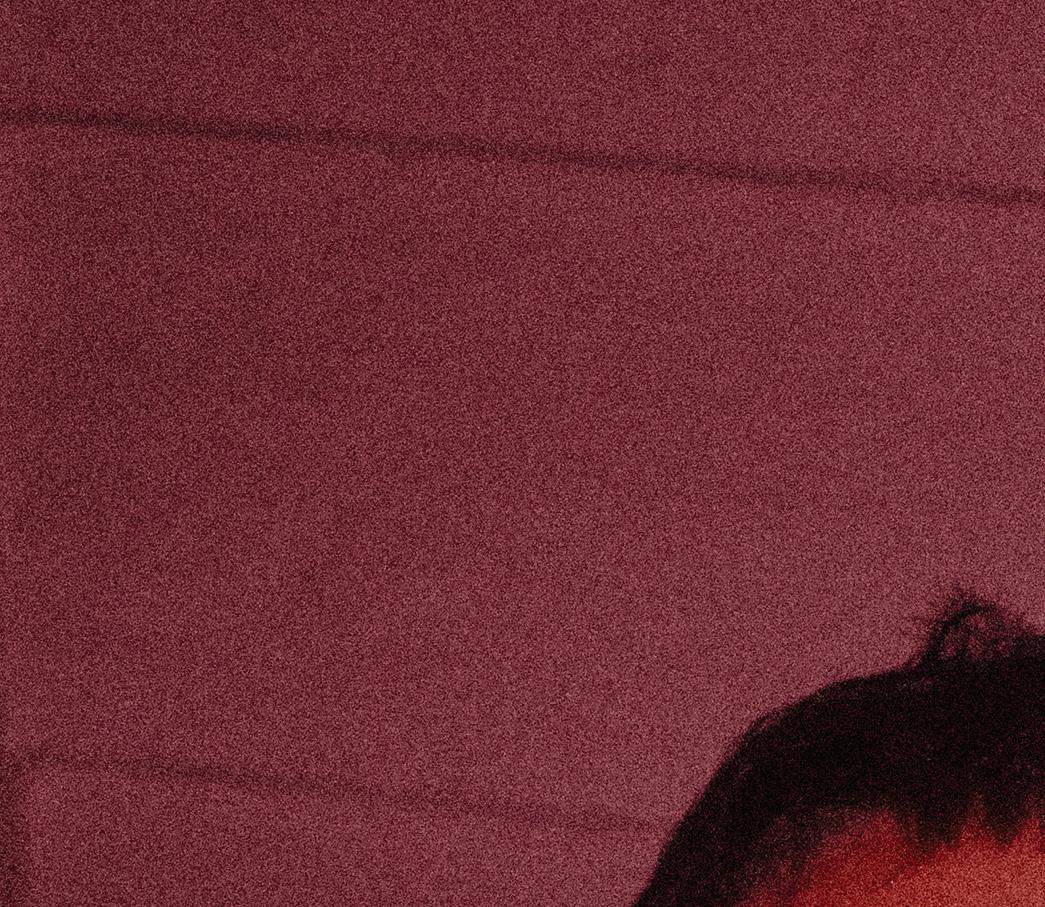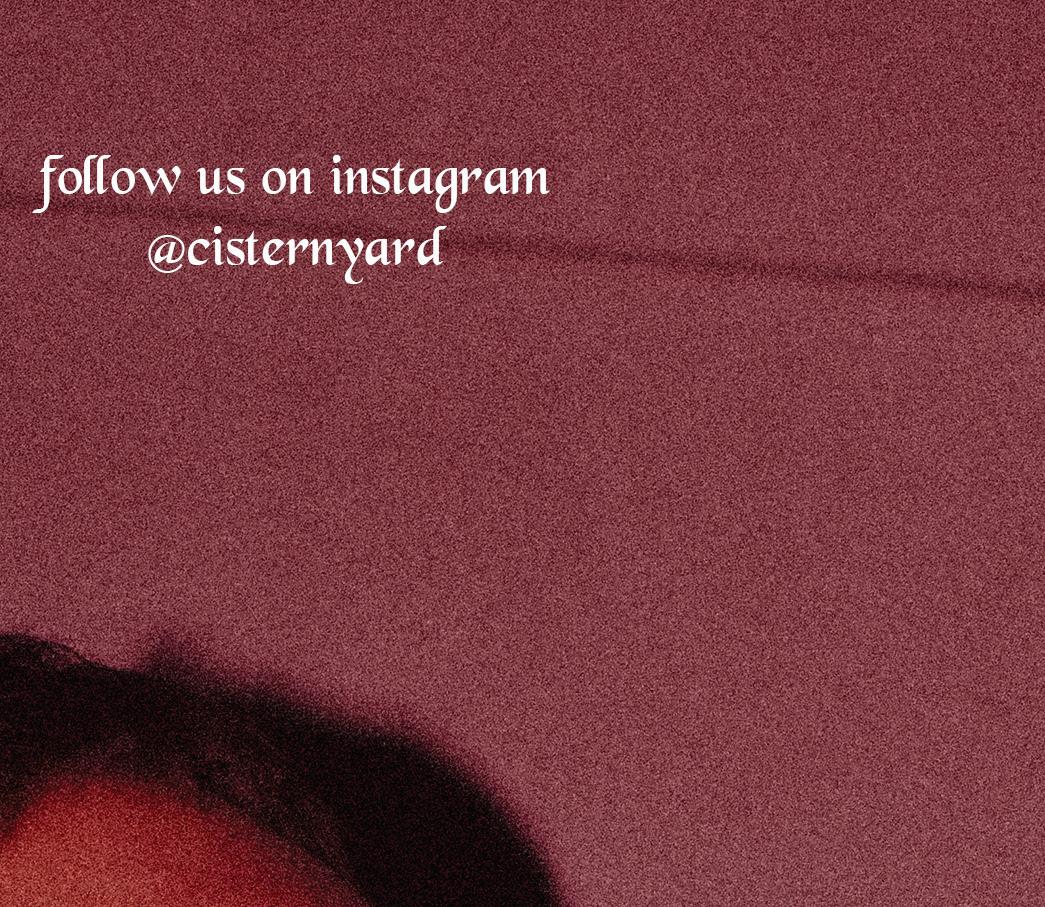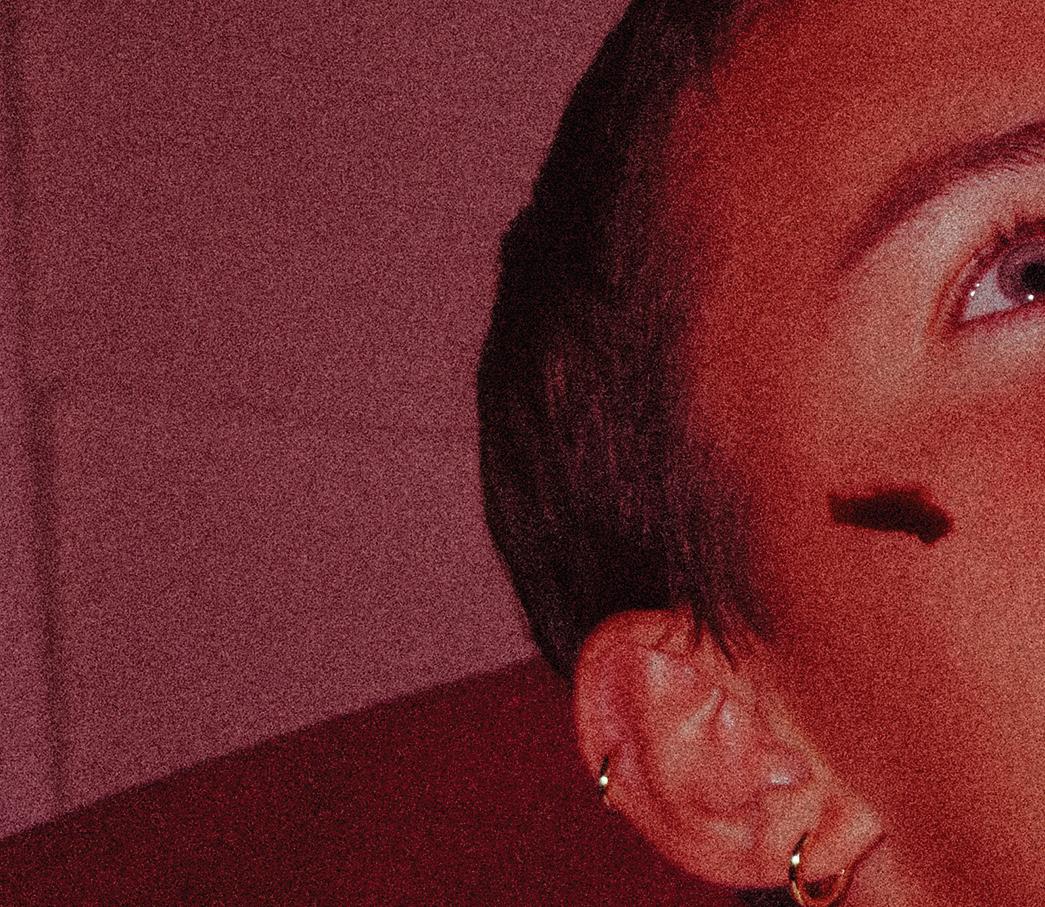


































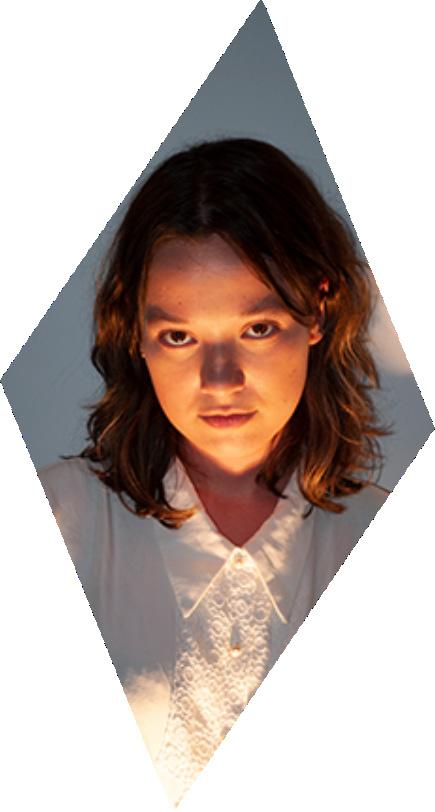
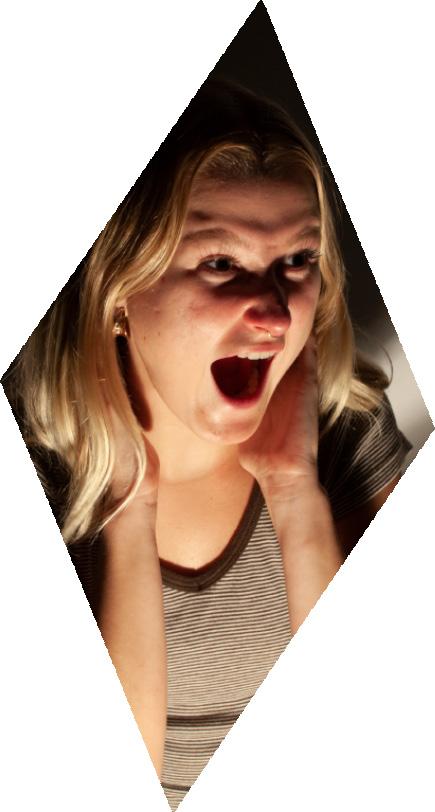




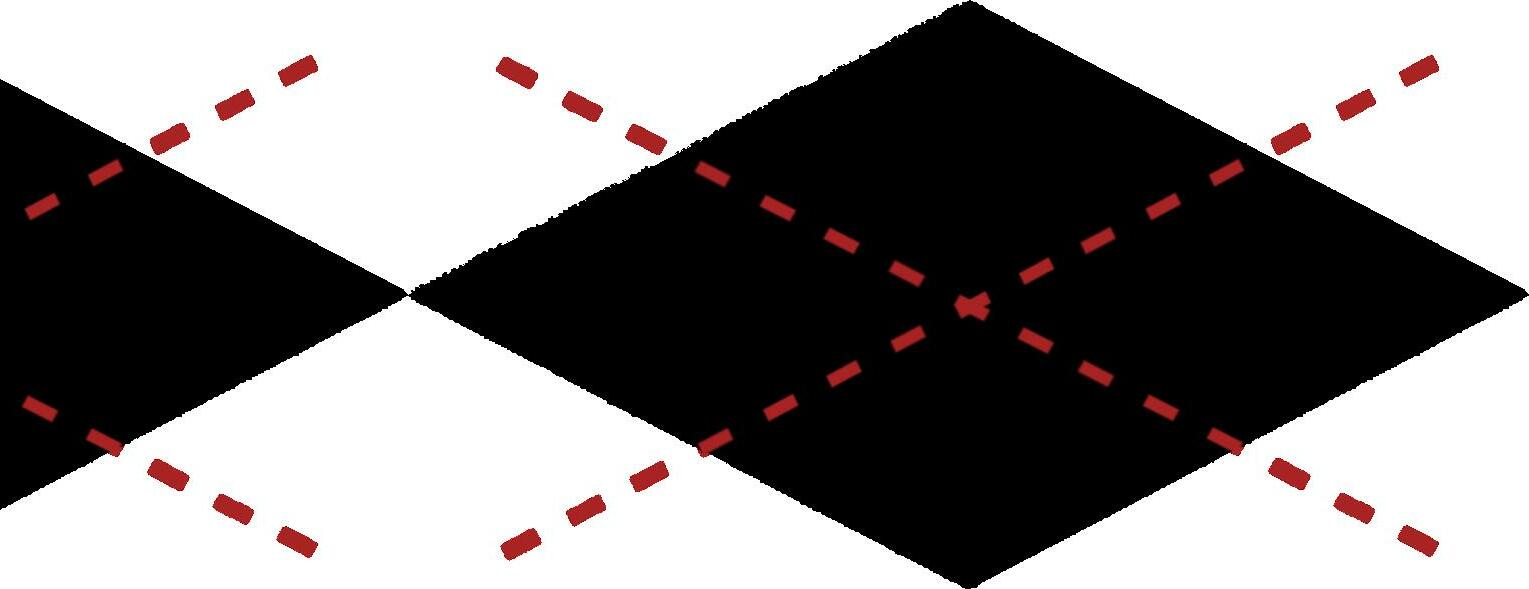

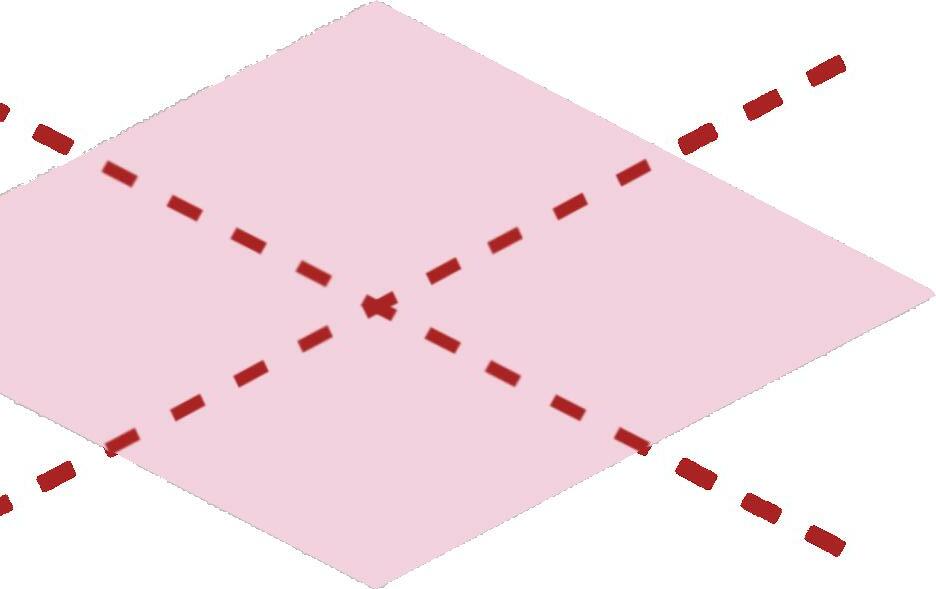














ere’s something about fall in Charleston. Although the weather rarely drops below 80, those rare days with a chilly breeze make it all worth it. e crunch of leaves beneath your feet, pumpkin bread (and mu ns, and co ee, and candles), and the ability to wear a light sweater are the time-honored, well-loved hallmarks of the season. So, it might be more about the aesthetics than the actual feeling of fall, but those aesthetics ring true each and every year.
But that slight breeze brings something with it– it’s hard to live in Charleston and not believe in ghosts. It’s hard to deny the omi nous aura of those iconic steeples stark against the night sky. e iron gates of cemeteries lay mysteriously open, and the dark streets lit by seldom-operating streetlamps seem scarier than usual. e history of Charleston feels alive and breathing, and you never quite know what’s lurking over your shoulder. It’s the sea son of scary movies and not looking out your window at night, of keeping those protection charms by your bed and throwing salt over your shoulder. And, of course, it culminates in my personal favorite night of the year: All Hallows’ Eve.

To celebrate the holiday, we had to bring back the beloved Halloween issue. is issue came together quicker than I’ve ever seen, and it’s all due to the ambition of our incredible volunteers. We had our fair share of obstacles, as always, but I’m proud to say that this magazine is the stunning culmination of weeks of hard work. Get ready to relive the romances of Rory Gilmore, and debate the queer symbolism of Bu y the Vampire Slayer. Refer to our Creative Director’s second annual costume rating for your Halloweekend celebrations, and study up on Rocky Horror’s generational impact.
So, cuddle up with a warm blanket and a pumpkin spice latte, or a bucket of popcorn and a classic slasher– whichever version of fall ts your vibe. Dig in to this year’s Halloween issue and celebrate the wonder of fall. And from the entire sta here at e Yard: have a very happy Halloween.
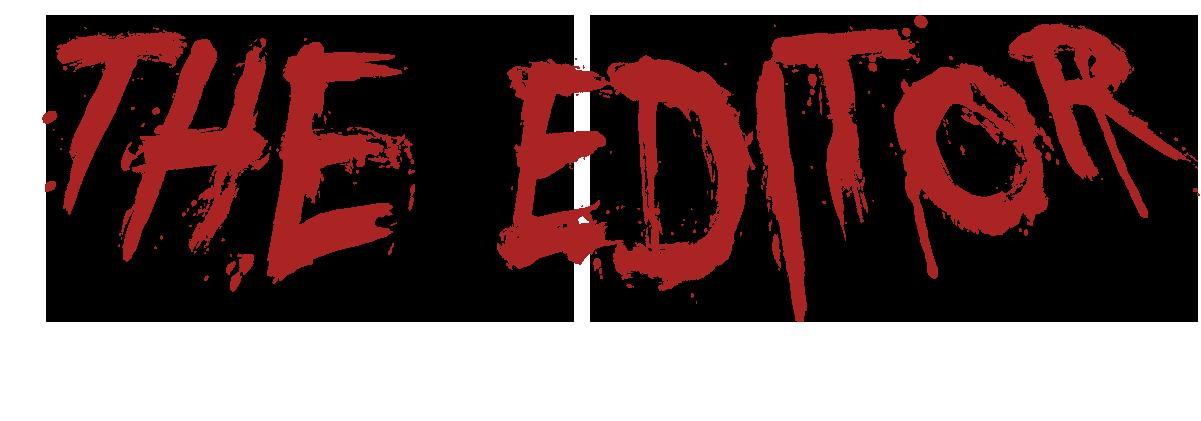





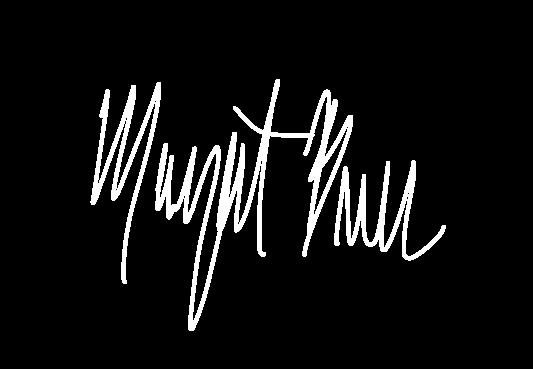 Margaret Bruce Editor-in-Chief Class of ‘23
Margaret Bruce Editor-in-Chief Class of ‘23

 By Margaret Bruce
By Margaret Bruce
During last semester’s spring election cycle, junior Sydney Maguire and sophomore Lexi Dowd were elected as President and Vice President of the Student Government Association (SGA) after a highly successful campaign. I had the pleasure of working with both of them during my own tenure in the organization. I joined them in the SGA O ce (located on the 4th oor of Stern and recently redecorated, thanks to Maguire) to chat about their expectations for this year and hopes for the student body.
Margaret Bruce: anks for joining me today. Could you introduce yourselves and explain why you got into SGA?
President Maguire: Sure. I’m a junior and an English major with a concentration in Writing, Rhetoric and Publication. I originally got involved with Student Government because I wanted to have some connections and involvement within the school, as I came in Fall 2020. I was interested, then went to an interest meeting and got involved from there. From that point, other members en couraged me to move into executive positions.
Vice President Dowd: I’m a sophomore, double majoring in Political Science and History. is is my second year with SGA. I joined because I had held leadership positions and done Student Government from elementary to middle to high school. I saw SGA at the involvement fair, then saw their social media and thought I would be interested. I was then encouraged to expand my involvement.
B: Both of you are kind of young for these posi tions. We usually see a junior and a senior as Vice President and President, or two seniors. What do you think you bring being a sophomore and a junior?
D: Being younger, we aren’t coming into these roles, doing our work, then leaving. We’re going to be here next year to see what happens after we leave. at perspective of actually experiencing changes we make changed the value we bring to
these positions.





B: How have you seen SGA change in the past year, and how are you looking to change it?
D: A big thing we want to bring is a new life to SGA. In a lot of ways, it’s been the same for many years. We’re looking back at what we used to do and bringing some of those things back. We also want to bring a fresh go of energy by getting new people from new areas of campus and bringing back those old traditions.
M: With each new administration, the organiza tion changes a little to match the goals and per sonalities of its leaders. It’s a big responsibility to set those values, but it’s fun and exciting. Lexi and I’s values revolve around listening to the rest of the organization and making sure everyone’s accom plishing goals and doing fun things. A big thing for us, personally, is trying to move away from the stu y, completely professional way people regard SGA–not that there’s anything wrong with that, but we want people to regard SGA more as a fun activity where people passionate about making change and being leaders can do that while mak ing friends and having fun.
B: SGA has held some big events in the past, like the Bike Auction. Are you looking to hold SGA-sponsored events, and how are you planning on boosting engagement?
D: e annual Bike Auction is coming up this year in October. We’re focused on branching out to work with other clubs and promote their events to create that network. We’d like to reach out spe ci cally to clubs and invite them to come to our events. We want to improve overall outreach to organizations.
M: at goes into one of our pillars that we ran on that we want to keep at the center of what we do: partnership. It’s not a transactional thing, but trying to genuinely keep partners in mind to gure out what they’re excited for instead of what we think would be fun. We’re going to talk to



students and leaders speci cally to see what they’d enjoy.
B: Speaking of your pillars, you had four that you ran on. Would you say partnership is the one you’re most excited about?
M: I think all of them mesh really well. Our pillars were sustaining diversity, a sustainable environ ment, sustaining mental wellness, and creating sustainable partnerships. All of them are consider ations we want to put in everything we do.
D: A lot of them are weaving together. We’ve strengthened our partnership with the Center for Sustainable Development. is is a ful lled, excit ing partnership that gives SGA a hand in sustain able e orts on campus.
B: at leads into a problem that’s been prevalent in SGA: many students don’t feel represented. What are you doing to remedy that?
M: We’re continuing with our partnerships, and we know that SGA is not the venue for everyone. People who are very outgoing and love to be visi bly involved on campus feel comfortable, but we’re trying to make it more welcoming for those who don’t have that demeanor, while also recognizing that it might not be the organization for everyone. It’s important to have partnerships with other organizations so people can still have a seat at the table without coming to every Senate meeting. We’re creating an open and welcoming environ ment– that is the most important thing this year. at is the way we get diverse voices involved. If someone has one thing, they can come talk to us about it. We’re working on making our organiza tion accessible to as many people as possible.
B: A lot of students are also confused about what SGA does. Could you summarize what it is to you?
D: e role is to be the liaison between the stu dent body and administration in order to make positive changes, so everyone can ourish.
M: It’s not just making the changes, but facilitat ing communication. Going beyond admin, it’s our job to connect students to the greater Charleston community and the state of South Carolina.
B: SGA elections often have low engagement. What are you doing to get students to vote?
D: We had the Election Commission tabling during our most recent election. at was great from last year, because students physically saw polling going out. Everyone was out there and had that interaction going, so we wanted to bring it back– it was a good precedent.
M: Do you want to talk about the spam situation?
D: Oh yeah, so a lot of our emails coming through Dr. Caudill on our behalf are going to students’ spam or junk mail. Students just aren’t seeing it.
M: It’s happening with a lot of other o ces, as well.

D: Yes, a lot of important things are going to students’ spam. We’re working with Mark Staples to get that xed, because students are missing important information.
B: Looking back to issues prevalent in other administrations, two main ones were COVID-19 and the housing crisis. How are you dealing with the ripples of those events in your administration?
M: Starting with COVID, we’re obviously follow ing College guidelines. I think what we learned from COVID is that our attendance policies should be reasonably lenient. We shouldn’t expect people to be working when they’re sick. Being understanding and forgiving is an important value I’m proud to say we’re implementing.
D: Coming o of COVID, students are excited to go to in-person events and meet people face-toface. We had a few students ask if we were online and they were excited to hear that we were in-per

son. We’re being safe, but students are excited, so we want to provide that venue.
M: As far as housing, we learned a lot last year in how to communicate e ciently with administra tion, as well as how to push back when we don’t approve. Continuing that is very important. Also, as SGA President, I attend Faculty Senate as an cio member. I’m glad to say that a lot of faculty and administration are cognizant of those issues and are very diligent about making sure that extreme advanced planning is happening, especially with housing. We’re making sure that, at any table we have a seat at, we’re continuing to ask questions and push administration to make sure they’re being thoughtful and considerate.
D: Two weeks ago, I was on a panel with a poten tial future Student Life employee, and I was able to ask them questions. I asked them a question with housing in mind, saying that, you know, this happened and how would you feel about work ing with students on that when you don’t see eye to eye, and how would you handle that. I know that when I look at that, it helped me position a viewpoint of administration. ose reactions are important to keep in mind.
M: I also think the repercussions of the way it was handled are ongoing. We like to think we’re past it, but student perception of administration has been tarnished. We’re making sure they’re aware and we’re holding them accountable to repair that. We’re trying to be considerate, keeping in mind that people had their housing plans a ected and that can change the way they’re moving through the world this academic year.
D: I hope that we bring in a lot of new things–new energy, getting more people interested to know what’s going on. I hope that pattern keeps going and brings a new life, bringing SGA back to having a central role on campus where students know what’s going on and are excited. We only have a year, so we can’t make every change, but we would love to see that trend going.
M: I’m excited about partnerships with other orga nizations. I want to see them grow and strengthen, so the next President of each of these organizations will have that relationship, so we can hold events, collaborate, and support one another.



B: If you have one message you’d like to send to the entire student body, what would it be?
M: I talked about this at convocation– I think buying in is the most important thing you can do. We’re here for a nite amount of time, so even if it feels corny, go to the events, join a club, stay and talk to your quirky professor. Be in college, embrace it, and take advantage of the opportunities.
D: I like that. You’re here and you should, like, commit to the bit, you know? You’re only a college student for four years. I had my senior year and half of my junior year taken away from me and that’s made me change my point of view. Take your opportunities because they might not come again. Class may not happen tomorrow, so take the chance when you can.
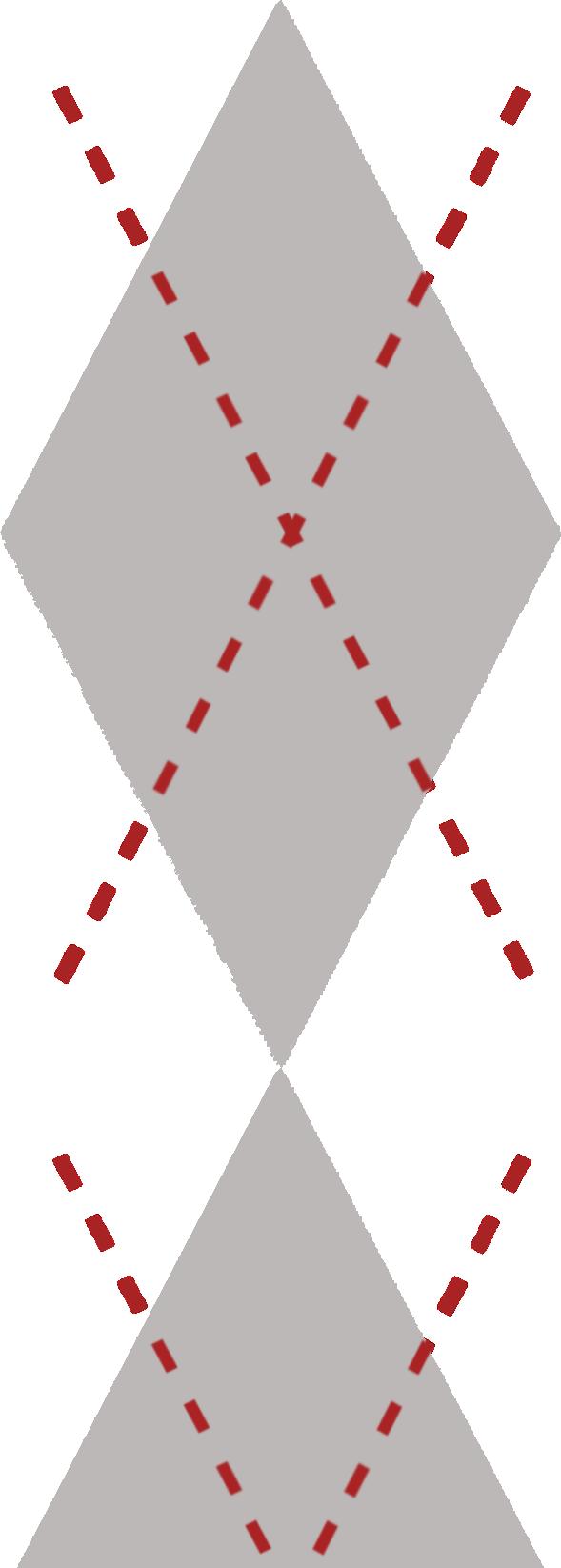



CisternYard News is getting really tired of issuing this warning every year. When you’re debating costumes for this Halloweekend, consider this: Don’t be an asshole! Although you really shouldn’t need it, here’s some ideas on how not to be an asshole:
Don’t be a homophobic or transphobic asshole!
If the joke of your costume is that you’re dressing up as someone LGBT+, don’t do it! It’s that easy. Do you really want to parade your insensitivity all around Charleston? Bad idea, bad costume.
Don’t be a Xenophobic, anti-Semitic, or otherwise intolerant asshole!
If your costume revolves around impersonating a religion to which you don’t belong, it’s probably a bad costume. No need to add to hundreds of years of oppression and intolerance by dressing up as a terrorist or a Nazi. It’s not ‘dark humor,’ it’s just being an asshole in a stupid costume.
Don’t be a Racist asshole!
If your costume is based on racial stereotypes of any kind, then it’s probably a bad idea. And again, we shouldn’t have to tell you this–black/brown face is incredibly racist and is never an acceptable costume. Grow up and educate yourself instead of being an asshole.
Don’t be an oversexual or violent asshole!
If your costume incites violence or oversexualizes a group that in no way asked to be sexualized… ew. I think we can all agree that we, as a society, have moved past infantilizing women for a costume. If you’re impersonating a child, but trying to make it sexy, you might just be an asshole.
Don’t be a Privileged asshole!
Charleston has a high population of people experiencing homelessness– that doesn’t mean it’s funny or cool to dress up as them for Halloween. All you’re doing is aunting the fact that you’re privileged. Not funny, not cool, and not a good costume.
Don’t be an insensitive asshole!
You’re a college student– social media keeps you up with the times. So, I hope you would know better than to think of dressing up as a cop, a prison inmate, or a ‘gangster’ this October. ese are incredibly nuanced sociopolitical issues that can’t be boiled down to a costume you put on for one night. It’s not a ‘classic’ costume, you’re just not that creative.
The point of Halloween is that you can dress up as anything you want– so why choose something that shows off your ignorance? Be a space cowboy, a lifeguard, be sexy Abby Lee Miller for all we care– just don’t be an asshole.










 By Blakesley Rhett
By Blakesley Rhett



nal girl trope has been etched into the horror movie franchise for many years, with many varia tions of the character being seen throughout di erent movies and series. For this Halloween season, I have tasked myself with breaking down the trope and trying to solve the mystery of why the nal girl character is so essential to the horror genre and has made such an im pact on audiences. A er all, people love to root for the girl who nishes the killer o , walks o into the sunset, and leaves the traumatic experience behind her…at least until the sequel.
e idea of the nal girl has evolved throughout the years, originally dating back to the classic damsel in distress trope where a lady or a princess needed to be saved by someone other than herself. In more modern times, this idea has adapted into what we know today as a woman who is in distress but is able to escape the situation herself, using her own set of skills and assets.
e rst modern idea of the nal girl was Sally Hard stey, who appeared in the original Texas Chainsaw Massacre that hit screens in 1974. e character outlived her friends and outwitted the classic killer Leatherface, even if she lost her mind in the process. is trend has become very popular over the past ve decades with nal girls popping up in almost every horror movie since then.
But who really is the nal girl and why has the trope stayed so prominent in the horror genre for so long?
or the need to protect someone like a sister who the killer is targeting. Something or someone drives her to












Gilmore Girls is a television series for lovers of fall, small-town charm, and the early 2000s style. Many teenage girls of this generation value the pseudo-nostalgia brought on by the day-to-day story of the lives of Rory and Lorelai Gilmore. roughout the series, the Gilmore women never cease to attract many love interests, with Rory’s rela tionships held at the forefront of the storyline. is is where many fans of the show like to stir up a bit of light-hearted

controversy with just one question. Who was Rory Gilmore’s best boyfriend? A simple name does not do this question justice. Who was really the best man? Was it the man who had all the suitable characteristics—kindness, charisma, strength—that truly deserved her love? Or was it the man who taught her to have fun, eat ice cream instead of study, and lay on the road in the middle of the night watching the streetlights turn colors? Maybe it was the man who supported Rory throughout her time in college, jumped o sca old
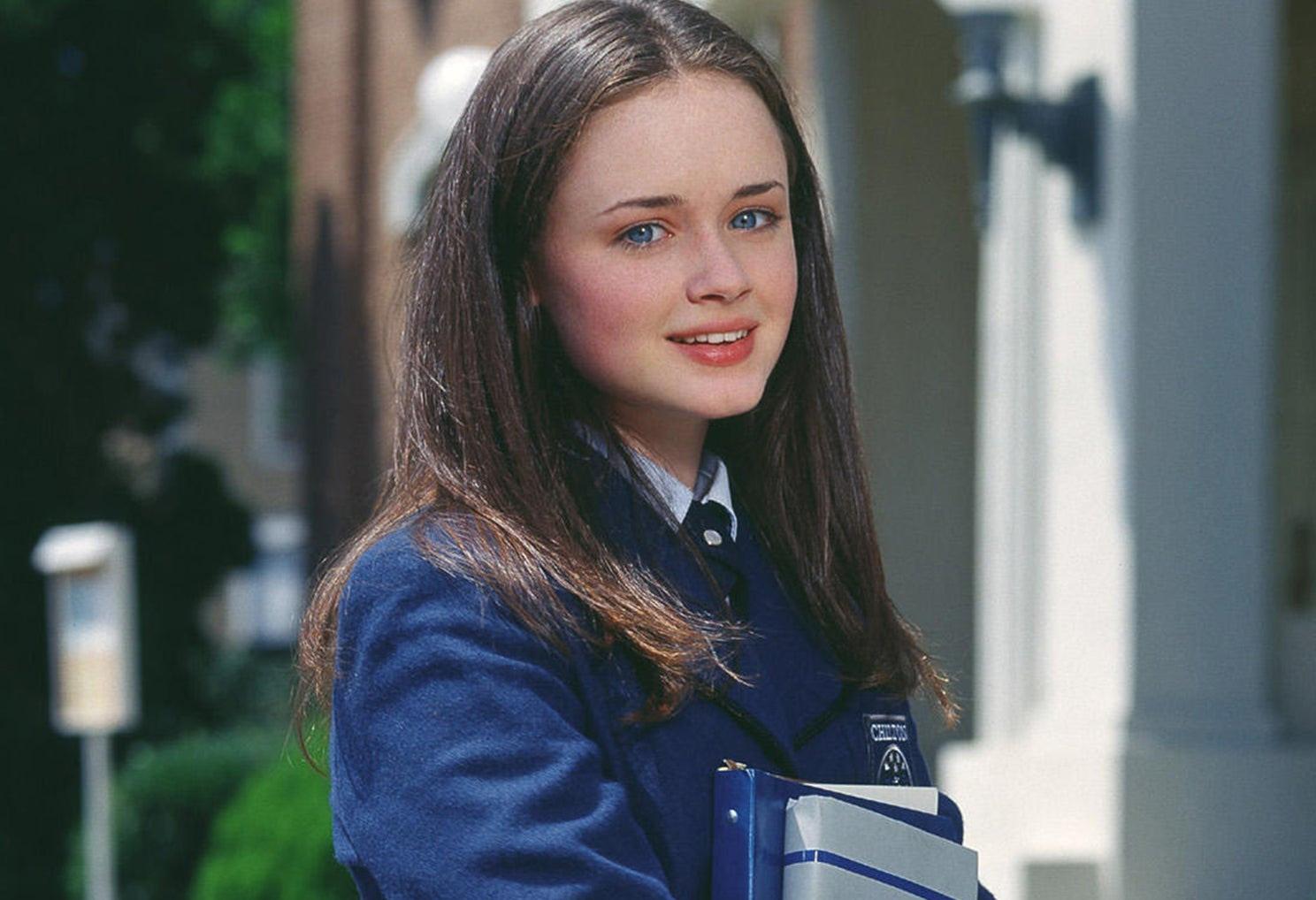
ing holding umbrellas with her (yes, really), and gave her a rocket to symbolize just how long he would love her. What does it take to win this battle of the best? It is important to take into consideration Rory’s stage of maturity during these relationships. ere are key connections between her personal development and the men (or boys) with whom she becomes involved. I have to take a moment here and note that there will most de nitely be spoilers included in this analysis (if there hasn’t been already), so consider this a fair warning to anyone who has not yet jumped on the infectious wave of the Gilmore Girls fandom.

she knew she could always nd comfort in him no matter the circumstances. However, Dean was not the best boyfriend for Rory. He had all the right qualities for a great rst boyfriend, but she simply grew out of their relationship. Dean was Rory’s rst kiss, rst love, and rst heartbreak. is is what causes Rory to keep coming back over the years– that comfort in nostalgia and the innocence of their relationship. When she encountered di culties in her life, later on, she often ran back to him. is showed her frequent desire to go back to her younger days when things were easier to handle. Dean, still hung up on their teenage romance, welcomed her back each time because he just couldn’t help himself.
While he was not an o cial boyfriend, it is important to note the dynamic between Tristan Dugray and Rory. Tristan was one of Rory’s classmates at Chilton and immediately took a liking to her when she rst transferred to the school in season

Rory’s rst boyfriend was the typical “boy next door” (barring some unresolved anger issues), Dean Forester. eir whole some relationship was one that any teen girl would be jealous of. It is clear from the beginning that Dean was always a little bit more committed to their relationship than Rory. He was always ready to help Lorelai around the house, seemed to be genuinely invested in her interests, and knew her movie refer ences. One of Dean’s major aws was that he always moved a little too fast in their relationship. Romance was new to Rory, and his eagerness to declare his love caused a lot of anxiety for her. at being said, he was incredibly resilient when Rory’s wandering heart found a new object of desire, Jess Mariano (more on him later). Dean’s determination in making their relationship work was admirable but ultimately left him to act out in frustration with her carelessness. is con ict high lighted the juvenile nature of their love.
Dean was a good boyfriend because he actively tried to put e ort into their relationship and keep Rory happy. Rory’s relationship with Dean is symbolic of her transition from adolescence to adulthood. He was a safe space for her, and
one. At this point, Rory and Dean’s relationship had just taken o , and Tristan created a lot of con ict between the two young lovers. Dean would often get jealous of the attention Tristan gave Rory, and his protective attitude would show. is foreshadowed the struggles of jealousy that prevailed in each attempt at a lasting relationship.
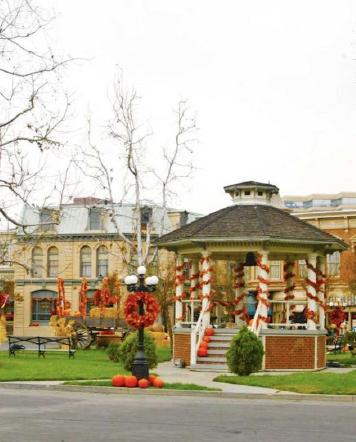
As mentioned before, the arrival of Jess Mariano complicat ed everything for Rory. Despite her relationship with Dean, it was clear that Rory and Jess had an e ortless connection, even though she tried to deny her feelings. While Dean knew some of her movie references and tried to read books to relate to her, Jess had a natural intellect and genuinely the same
interests in literature as her. Jess cared about and knew Rory’s goals. In fact, it was him that persuaded her to go back to Yale after her mid-college crisis that resulted in her dropping out. Sure, Jess de nitely had his pitfalls, but he never tried to hold her back from her goals, and he knew when it was time to be out of her life. In the end, Jess was the only ex-boyfriend she spoke regularly with, and they maintained a healthy friend ship. If their romance had begun when Rory wasn’t already in a relationship, it is possible they could have lasted longer. Nevertheless, Jess was still not the best man for her. He was disrespectful to Lorelai and emotionally manipulative toward
relationship, Logan prioritized Rory and was a great friend and boyfriend, no matter what happened between them. Rory made the decision to take a break from her studies at Yale, and Logan supported her decision in every way possible while still trying to make sure she succeeded. ey broke up brie y when Logan’s pretentious upbringing came to the surface at a family dinner with Rory’s grandparents, and Rory was left to reevaluate. Nevertheless, Logan won her back in his usual extravagant displays of a ection. One of the most impact ful moments in their relationship was when he sent Rory a rocket ship while they were doing long distance. In reference to a movie they watched together, the rocket represented his undying love and how he would wait for Rory forever if that’s what it took Logan and Rory’s relationship was di erent from previous ones because there was a new sense of mature love. ey could both see a potential future together. Logan is the only boyfriend that Rory’s grandparents ever approved of, granted in large part because of his family. is made their

Rory for his own entertainment. He stole the bracelet Dean gave Rory for her 16th birthday, causing her to go into a fren zied search. He actively pursued a romantic relationship with her, knowing she was already in a committed relationship. Jess also never had the con dence in himself to achieve his dreams. is lack of con dence negatively a ected their rela tionship and made a future together impractical. Jess was the man who showed Rory how to have a good time and worry a little less, but he was never meant to be the man for her.


Logan Huntzberger rst appeared as a pretentious jerk who had little regard for others’ feelings. He would tease others relentlessly with his goofy friends and act as if rules really did not apply to him. Rory was not impressed by Logan’s behav ior, but as Rory and Logan grow closer through their work at the Yale Daily News, she sees that Logan’s stuck-up person ality was more of a facade due to his father’s in uence and his desire for approval. Beneath his sour surface, Logan was caring and thoughtful. He took Rory to events at his secret society and reminded her to live a little in the midst of college stressors. Early on, this showed the soft spot he held for her, as bringing in an outsider was a very big deal. roughout their
relationship more practical in their pretentious society that valued a family name. Wholistically, Logan was the best boy friend for Rory. He cared for her in a way her other partners weren’t capable of ful lling. Rory’s character took a downward spiral sometime around when she dropped out of school, and by the time this happened, it was clear she was not the same person fans knew and loved in the earlier seasons. In many ways, Rory became the same type of snobby person her mother tried so desperately to avoid in her upbringing. Logan wanted to marry Rory, but by the time the proposal happened at graduation, Rory was not ready to make the commitment. In the end, Logan was the best man for her, but Rory was not the best woman for him.
The weather is finally cooling down, and it is officially Fall in the lowcountry. Take a look at some fun events happening during the season in the area!
With Halloween coming up soon, a ghost tour is the perfect way to ring in the season! With over twenty companies and experiences to choose from, such as the Charleston Supernatural Tour and Narrated Haunted Ghost Cruise of Charleston Harbor, you can go on a walking tour of di erent haunted sights or even hunt for ghosts yourself.
Located in Mount Pleasant, South Carolina o of Highway 17, Boone Hall plantation o ers a haunted experience through the month of October. is year, they have three attractions called e Lodge at Willow Ridge, Freaks (World of Oddities) and Sinister Cinema (Haunted Hayride), and you can purchase tickets on the Boone Hall Fright Nights website.
Presented by the Preservation Society of Charleston, customers can purchase tickets to go on walking tours of Charleston’s historic houses, landmarks and gardens. e Pizza’s and Gardens tour o ers “ 4-6 private properties in the Old and Historic District,” and the society also o ers Specialty tours that “are designed to provide a closer look at the Preservation Society’s advocacy work, preservation initiatives, and mission.” With the weather cooling down, this is the perfect opportunity to enjoy the city’s scenery and landscape. Purchase tickets on their website,: https://www.preservationsociety.org/events/fall-tours/the-fall-tours/#tours-nav
With the humidity nally out of the way, now is the perfect time of the year to explore the famous Cypress Gardens! Located in Moncks Corner, which is about 20 miles outside of downtown, you can buy tickets on their website to take a tour through the gorgeous swamp and gardens where the movie e Notebook was lmed. is would be a perfect Fall event for clubs, sisterhood events for sororities and the perfect activity to enjoy in this weather! You can buy tickets on the Cypress Gardens website.
Fall is normally the time when people start putting pumpkins outside on their porch, so there’s no better time of the year to go pumpkin picking!
Boone Hall Plantation in Mount Pleasant, Legare Farms INC. in James Island, and the Pumpkin Patch at Mistletoe Lane in Summerville are three pumpkin patches in the area that o er pumpkin picking.

 By Grace Tener
By Grace Tener

As Spooky Season commences this fall, we are re minded of a classic cinematic spectacle that brings the horror of Halloween to the big screen in a typical movie industry fashion.
For fans of all things scary and frightening, nothing says horror quite like a slasher movie. is popular sub-genre has continued to gain attention over the years for its uniquely suspenseful and gorry content.
Halloween lovers can't get enough of these blood and adrenaline-inducing motion pictures. But what elements spe ci cally make the slasher lm a classic genre? Why do people continue to view these violent lms with a cult following? Well, look no further. Settle in your seat and grab the snack of your choice as we take you back in time to the rise of the slasher phenomenon we have all grown to love and fear.
Nothing says Hollywood like a “Golden Age.” e industry is built on a growing fascination with a particular genre for a number of years before the next fad is discov ered. Slasher lms are no exception and had their time in the spotlight from 1978-84. is six-year period cemented this genre’s popularity as an American classic.
Key elements to the plot of these iconic lms include creepy stalking by a masked individual of a group of unsus pecting victims. Also, a deranged killer (the more psycho pathic the better, of course) who always happens to choose a weapon that notoriously creates gory and hyper-realistic death scenes.


Let's talk body count: no good slasher lm concludes without a variety of casualties mainly caused by the main characters’ having the genius idea to “split up” the group half way through the lm.
Most action is perpetuated by your occasional jump scare and a mysterious reappearance of the supposedly dead murderer. Until… the nal girl remains. en, just when you think you have survived, she meets her inevitable doom before your eyes just as the cameras cut.
is terrifying plot has gripped viewers for decades and this time-proven successful genre gives goosebumps to horror en thusiasts even today. As you enjoy your Halloween festivities this season, give a slasher lm a shot or, rather, take a stab at a few classics. I am certain they will slash– I mean, smash your expectations. So, happy viewing… if you dare.
1. Peeping Tom (1960)
2. Psycho (1960)

3. Blood and Black Lace (1964)
4. Texas Chainsaw Massacre (1974)
5. Black Christmas (1974)
6. Halloween (1978)
7. When a Stranger Calls (1979)
8. Prom Night (1980)
9. Friday the 13th (1980)
10. The Prowler (1981)
11. A Nightmare on Elm Street (1984)
12. The Initiation (1984)
 by Tyler McCormack
by Tyler McCormack
























A momentous occasion for College of Charleston students, Halloween acts as arguably the most important benchmark of the fall semester. For one glorious weekend, students trade in their going out uniforms of blue jeans, black tops, and white sneakers and take to the streets as demons, Barbies, and Abby Lee Miller. While the childlike joy of dressing up as a favorite character or in a punny costume is a high we will forever chase, there is another dimension of the holiday that proves to be just as joyful, at least for me: being a hater. With twelve months to prepare, students inevitably put their costumes o until the last minute, taking to the streets in a sports jersey or bathing suit and attempting to pass as Tom Brady or a member of Baywatch. For a holiday as important to the social fabric of this college as it is, year after year, I am saddened by these half-hearted attempts at celebrating All Hallows’ Eve: which is why I’m here to provide some feedback on some Halloween costumes you can expect to see this year– and all out of the goodness of my own heart. You can thank me later.

Smartness:
With Halle Bailey’s upcoming debut as the iconic Princess Ariel upcoming, it’s no surprise to see the Little Mermaid on this list. It scores major points for sexiness, given her proclivity for seashell bras, and relatability, with the recently released trailer featuring Bailey as Ariel on everyone’s mind. While not explicitly funny or original, this costume is timely and is CY-approved, earning a total score of 18/25.
Smartness:
In what seems to be a fusion of two of last years’ most popular costumes, Cowgirl Barbie makes her grand debut on the Halloween stage. While it doesn’t jump out as a standout, I would argue that it’s better than being just a cowgirl or just a Barbie. ere’s high potential for some sex appeal, and the key to selling this costume is ensuring those key Barbie elements are there so you don’t look like just another rhinestone cowgirl. is costume in concept earns a measly 13/25 points, but with the right execution, could be a solid option.
Smartness: 4/5



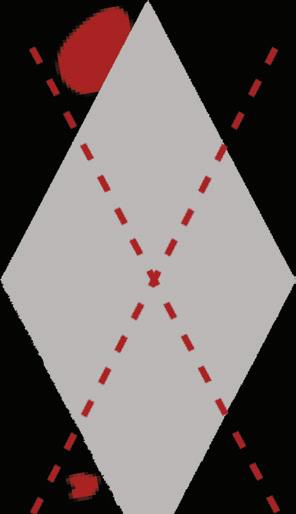

is costume de nitely has potential. e girls who get it will de nitely get it, but that comes at a cost– namely, the girls who don’t get it not getting it. It’s incredibly di cult to make a prairie dress sexy, and the lm’s themes don’t lend this costume particularly well to humor, but it scores high in the other categories. Taking home 15 of 25 possible points, Dani is a decent contender for a good Halloween costume this year– with bonus points if you have a man in a bear suit at your side.
Smartness:
When I started scoring this costume, I expected it to be in the high single digits; after some thought, however, I realized there are many merits of being everyone’s third favorite root vegetable. You’ll de nitely be the only one in your costume at any given party, and it’s sure to get a laugh after confused onlookers get up the courage to ask what exactly you’re dressed up as. Getting knocked for its sexiness and relatability, Rutabaga costumes are clocking in at 14 out of
points this Halloween season.

Smartness:
Vanellope Von Schweetz, probably more easily remembered as the little girl in Wreck it Ralph, is an interesting choice for Halloween costume. Not distant enough in history to be a classic and not recent enough to be on most people’s minds, Von Schweetz as a costume loses points across the board: de nitely not sexy, not particularly funny, smart or original, and hardly recognizable. My advice? Movie character costumes are like ne wine– the older they are, the better. Stick this costume in the closet and re-evaluate in 3 years. Minimum. 11/25.




Smartness:
In my many (2) years as a Halloween costume critic, I have noticed a trend at the College of Charleston and in the culture as a whole towards funny or gimmicky costumes and away from classic ghouls, goblins, and ghosts. While this costume doesn’t fall into the latter category, its source material is scary, which is a refreshing departure from the sea of space cowboys and angels we’ve seen ood the streets in recent memory. Scoring big on originality, smartness, and relatability with some brownie points for being a multi-person costume, the Shining Twins clock in at a pretty solid 16/25.
Smartness:
Sometimes, in life, great opportunities arise– those of the kind that it would be foolish to turn down. Dressing as sexy Sue Sylvester for Halloween is one of those opportunities. Witty, sexy, and original, this costume is relatively simple while still packing a Halloween punch. Points were docked due to the inherent unsexiness of a tracksuit and because not every person will know who this costume is. However, do you care about the opinions of those who never watched Sue terrorize her Cheerios? I think not. is costume gets a solid 22/25, because that’s how Sue C’s it.
Smartness:

is costume’s only saving grace is its recognizability: however, commitment to this costume involves at minimum some sort of hot pink or blue skin makeup and an absurd hairdo, losing it points in sexiness. ese points, in a good Halloween costume, would be earned back by its humor. However, that brings us to the main point: this is not a good Halloween costume. 11/25.

Smartness: 5/5 | Sexiness: 1/5 | Funny: 5/5 | Originality: 5/5 | Relatability: 5/5

e thumb people from Spy Kids burned themselves into the collective memory of a generation when they fought Shark Boy and Lava Girl in 2001. is costume is instantly recognizable and iconic, scoring perfectly across all categories except for sexy: and honestly, who cares? is is a sure re way to win any costume contest, and de nitely take home the most laughs. Alongside its score of 21/25, this costume gets one giant thumb-person up.
Smartness: 4/5 | Sexiness: 2/5 | Funny: 4/5 | Originality: 4/5 | Relatability: 3/5
People stuck in the 2010s su ered a di cult loss this month when the news broke that married Try Guy Ned tried something other than monogamy. at being said, current events make great source material for Halloween costumes, and Ned’s now-fractured marriage, personal, and professional life are sure to provide inspiration for a decent costume. Scoring towards the middle across all categories, Ned costumes are clocking in at a surprisingly high 17/25.
Smartness: 3/5 | Sexiness: 3/5 | Funny: 5/5 | Originality: 3/5 | Relatability: 5/5
Given its status as the College of Charleston’s second favorite state to get students from, New Jersey has made relatively few forays into the Halloween costume scene. e proliferation of New Jerseyans on our campus is exactly why this costume is a great option: it’s funny, instantly recognizable, and shockingly few Cougars have adapted this TV legend for Halloween, at least in recent memory. Multiple people in the house know, therefore you should know the truth: Snooki is a great Halloween costume option. 19/25.

Smartness: 4/5 | Sexiness: 4/5 | Funny: 2/5 | Originality: 4/5 | Relatability: 4/5

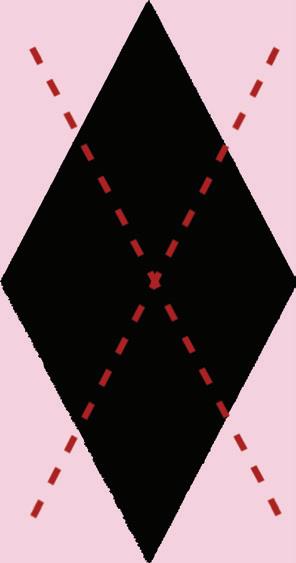


Halloween is an excuse for extravagance, and this costume has it all– corsets, pearls, wigs, tights, medically small dogs, and, of course, cake. is costume also nds itself at the intersection of Halloween and fashion, allowing you to utilize current trends like pearl chokers and corset tops as a part of your costume. Glamorous and sexy, this costume scores high in all categories except humor, netting a total score of 18/25.

 By: Anna Rowe
By: Anna Rowe






Loneliness sucks. Big time. I was never familiar with the word lonely until high school. Suddenly, I felt it when I was sitting with my friends during lunch, riding on the bus to a soccer game with my teammates and even tearing up the dance oor at Prom. I couldn’t understand why I didn’t feel full when I was surrounded by people I liked, people I knew and people who I talked to. is started in high school and so far hasn’t stopped. At rst, I assumed that it was because I was stuck in an itty bitty town, surrounded by people I have known my whole life. I needed a way out: that’s when I realized college would be my answer.
My senior year, I was so excited to leave my hometown and get out of the lonely hole I dug myself in. But then, COVID hit. My social life went to shit and loneliness became my only friend. My feelings were all too familiar. I would lie in bed all day with loneliness by my side. It would follow me on walks, when I scrolled through social media and dinner with my family. It was like loneliness would wake me up everyday greeting me with a “good morning,” even though we both knew it would not be. Luckily, I had my sister who kept me entertained, from our long night drives to binging our favorite TV shows.
Although loneliness wanted me to believe I was complete ly alone in my home, my family made sure I wasn’t that gullible.




After weeks of postponing the allowance of students on campus, the CofC president nally gave us the go-ahead to return. I thought that when I stepped for the rst time onto the bricks at the College of Charleston, loneliness would nally leave me alone. However, I must’ve acciden tally packed it in my suitcase, because it followed me all the way to Charleston. Somehow, within the rst week of college, people were walking down the street in actual mobs. ey would take up the entire sidewalk, laughing and talking. ere was no way they were lonely! ey all had friends. ey all had company. I assumed that I was always lonely because I didn’t know a lot of people. I joined a sorority, hoping that belonging to something would shield me from being lonely. I met some super rad people through that, but the feeling quickly came back. I joined clubs. I met my neighbors. I went out to parties. I made friends. Every time I thought I nally got rid of that lonely feeling, it sneaked its way back. Loneliness was a pest.
Sophomore year was a bit better. I started to nd my bits and pieces of company, but it never felt like enough. Even as a junior, it still doesn’t. I have great pockets of friend groups, feel comfortable away from home and have a won derful support system. I have my own apartment, which I absolutely love, but I don’t live alone. Loneliness lives with me too. And takes up a lot of space – so much that I had to get a queen bed.
I must admit, loneliness doesn’t function on its own. at’s where depression comes into play. Like half of the young adult population, I have depression. With that being said, it doesn’t mean that I should feel lonely. College is supposed to be the best four years of your life, right? A community. A party every weekend. e only place where your friends are literally your neighbors. Where you can do whatever you want with your time. Everyone else has to
I feel as though I am alone in the world of loneliness, but I know that can’t be true. Over half of college students have reported feeling lonely. If you’re reading this article, you have probably felt it too! I decided to take a long, hard look at feeling lonely. People tend to confuse being alone versus feeling lonely. I am alone in my apartment right now, but I do not feel lonely. I am content with myself and being alone. It has grown on me– it’s a chance for me to do things that I want to do without others’ opinions.
I have come to terms with my own loneliness. It’s like that one person who keeps sni ing in class. Just get a tissue! Loneliness is so enticing. It can pop up at any time. I know for sure that it loves social media, any type. Social media has completely warped the boundaries of separat ing ourselves from society, so that when we are alone it instantly cascades disappointment that we aren’t out and about. I’m here to tell you that it’s okay to be alone! It is beautiful! It is necessary! And, whether you like it or not, you are going to have to love being by yourself, because everything in life ebbs and ows.
Loneliness will continue throughout my life, and I am okay with that. Being surrounded by so many people who seem to have a shit ton of friends doesn’t really help all the time, but it has allowed me to be more content with being by myself and enjoy the time I spend alone. You are not alone in your pitiful loneliness. I am lonely too, and so is everyone. Being alone is not lame or sad. It’s okay.
Bu y the Vampire Slayer has, in the traditional sense, faded into the media ling cabinet of “past cultural phenomenons that now are only recognizable by name.” At least, this only seems to be true. With the onslaught of Queer media, Bu y nds itself in a void. Is it a queer show? Is it 90’s gothic camp? Is it seven seasons worth of the same “save the world” white feminist trope? Is it a science ction epic that prides itself on extensive world-building to no real conclusion? How does it t into our now very vibrant (at least—in comparison to the recent millennia) landscape of Queer media? Even with Queer storylines being more and more relevant, it is arguable that Bu y stands alone in its longevity. Recent Queer TV is now riddled with the contingent fear
of possible cancellations—First Kill (2022) and Gentleman Jack (2019) recently being on the chopping block. More hit shows, like Our Flag Means Death (2022) and Harley Quinn (2019), also were rumored to be canceled upon HBO’s merger with Discovery +. In this landscape of our favorite shows being stripped away, poorly marketed or canceled, it feels comforting to re ect on a 7 season show that centered queer characters and their storylines, accentuating them with the melodramatic horror and monstrous world of Sunnydale— making it, arguably, the “perfect” fall media.
However, it is not stagnant in this comfort. Bu y is not simply a queer show with cozy Halloweeny par-
aphernalia (though Gile’s magick shop is beyond endearing). With the show’s creator Joss Whedon facing allegations of being blatantly cruel and misogynistic towards his female cast, the show is now ltered through this added lens of criticism. Charisma Carpenter, who played Cordelia throughout the show and the later spin-o series Angel, notably said that Wheden “created hostile and toxic work environments…callously calling [her] fat to colleagues when [she] was 4 months pregnant.” At the time of Bu y’s weekly airings, there was a lively WP online forum where fans could collectively scrutinize episodic themes and predictions. Entering the fandom’s scholarly noise, Whedon responded to a post referencing the sapphic connection between Bu y
and Faith. He repudiated the claims, condemning fans who look for “lesbian subtext behind every corner,” only later retracting his sentiments to further develop the queer tension between the characters. With this in mind, how can we understand Bu y and her best friend Willow as products of a writer whose infatuation with powerful women perhaps dissipated once it left the realm of ction?
How is Willow’s queer narrative a product of Whedon’s idea that being bisexual was an emblem of one of the many “things you can’t do… thanks to [the society at the time]?” Is it the “queer utopia” we think it to be?
Of the hundreds of scholarly papers devoted to Bu y, M. Keegan’s dissection of the show’s visual display of queer utopia comes to mind here. Keegan pulls from Jose Esteban Munoz’s work, referencing the notion that “the romantic practice of queer world building requires a simultaneous practice of world-destroying.”


Bu y the Vampire Slayer is not rooted in reality– it disturbs it with the paranormal. We watch the show expecting a turn in the domestic narrative. Somewhere along the run time, a vampire will show up, or a demon will break Bu y’s plans to have a “normal life.” Keegan argues that this is, in essence, building a progressive utopia for queer expression. e characters have to break the world, to build it anew.
Willow conjoins her newfound art of witchcraft and her infatuation with Tara (a shy, yet silently commanding witch that attends UC Sunnydale). In the episode “Hush” (1999), the two nd themselves moments from being attacked by the Gentlemen (the episode’s central antagonists who appear as two oating businessmen, the origins of Sunnydale’s “voicelessness”). Willow and Tara attempt to push a
vending machine to block the villain’s impending entrance, without success. is is when Willow turns to magic. Without a word, her brow furrows, her concentration visibly stern and steady. She can’t move it, not even with her new power. en, Tara holds her hand, and together, they obstruct the physics of weight, the very barriers of the material “normal” world, and the vending machine jolts with bold uidity. e newness of understanding her queer identity is paired with deconstructing what is considered plausible. Her magic breaks the present hetero-normative space, while her gayness becomes visible (at least, explicitly) for the rst time. Looking at this moment of Willow’s expression of queer love sets the imperative notion that her queerness is breaking the world around her. She does not ful ll the utopia of the “good gay citizen” (being palatable to mainstream media) but builds a new utopia altogether— where being queer is not molded to t any standard, where she can bend time and space with her magic as well as inherent identity. is is an integral standard of queer visibility, as Willow and Tara form an organic, natural romance (most notably—their expressions of love and connection do not mimic “masc/femme” tropes). Also irrefutably, this was a historical moment for the show’s trajectory and audience reception: a healthy gay couple was on TV long before the national legalization of gay marriage. Two witches were in love on the faded, bulky living room TVs that rested on 1999 Pottery Barn entertainment centers. Although being rightfully criticized as a moment of bisexual erasure (Willow “has to” identify as a lesbian, canonically reverting her past romance with Oz), it was still a monumental mark of Whedon’s interest in his characters being unapologetically themselves.
When Bu y rst reveals to her mom that she is a slayer, the scene famously mirrors that of a traditional, painful,
“coming out” sequence:
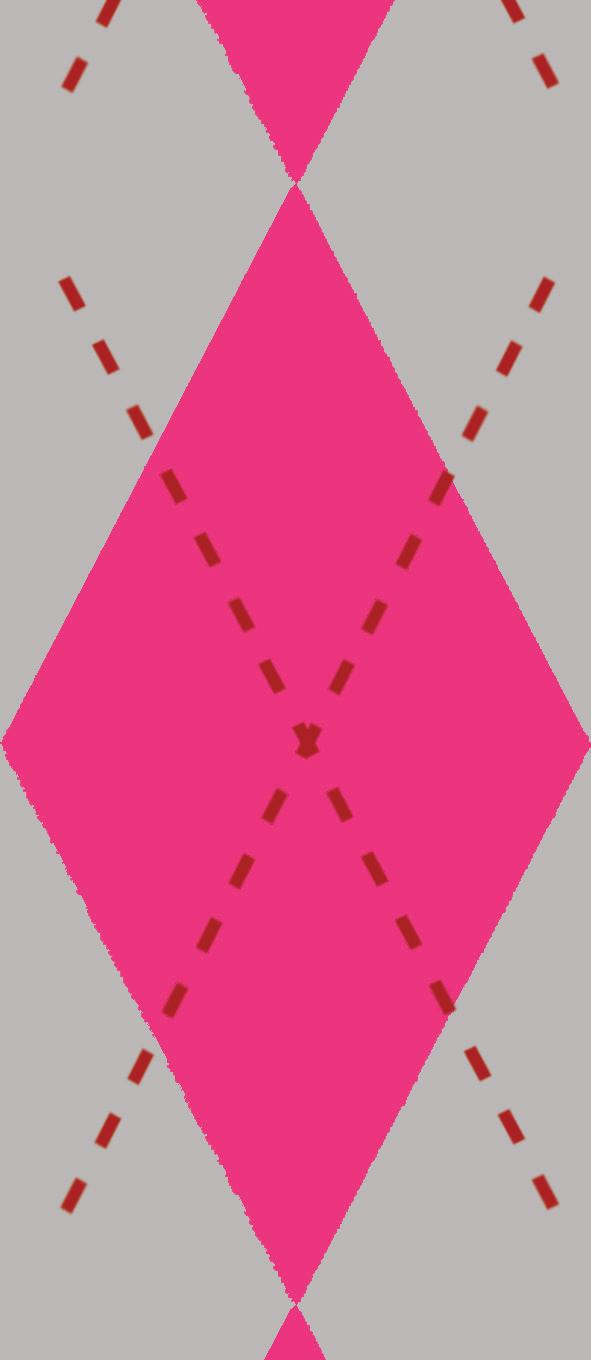


“I told you I’m a vampire slayer.”



“Well I just don’t accept that.”
“Do you think I chose to be like this, do you have any idea how lonely it is? How dangerous it is? I would love to be upstairs watching TV, and gossiping about boys, or God! Even studying! But I have to save the world, again.”
“You walk out of this house, don’t even think about coming back.”
Why then, fans like myself and others ask; Why does Tara tragically die, and Willow becomes the face of destructive magic? Why is Bu y’s queerness left unexplored and hidden only in innuendo until the Dark Horse Comics let her explore her love for another slayer named Satsu? If the broken world allows for this queer utopia, why break it even more? When questioned about the season ve nale— where Bu y sacri ces herself to stop the collision of worlds—Whedon responds with ambiguity:
“Obviously some things you don’t mess with and some things you constantly mess with. Our show is all about change and growth and living life and all it puts you through, but she’s going to be Bu y. I like Bu y,” Whedon said. “I’m not saying it will be smooth, go well and be exactly the way you remember her, but it will be Bu y.”
e breakage of the hetero-normative space makes way for queer characters to be themselves, even when that “self” is still muddy, distraught and confusing. Albeit a continuous choice Whedon makes, his queer characters navigate the gloomy path of pitfalls, and mistakes, reacting as if in direct conversation with their constraints. Whedon’s behavior being undoubt-
edly inappropriate and vile on set and his character not being as “feminist” as he aimed shaped his writing. Everything for his characters is an obstacle, a verbal tunnel—for better or for worse. Testing them was Whedon’s artform, his masterful repurposing of con ict into the paranormal, creating a show that twists and endlessly surprises the viewer with its eerie, painful familiarity. Being queer in this universe and in the paranormal means being in a constant push and pull, the preceding tension before the eventual breakage. Regardless of constraints, the moment arises when we transcend what we think we have to be and become what we have always been. We need to break the universe in order to rebuild our own, with small star fragments of personal truth. Moments of complete and vulnerable sincerity, to moments of complete and vulnerable sincerity. Each connects like a web until we live in our own, distinguished, factual, queer utopia of self.
CY Radio and 1770 Records
tunes curated by

(Don’t Fear) The Reaper - Blue Oyster Cult
VoOdoO ChilD (SlIgHt Return) -
Jimi Hendrix
Black Sabbath
The Orion Experience
Stevie Wonder
Black SabBAthVampireSuperstITionHeavEn KNows I’M miSeraBlE Now -
HEad Over HeElS -
Central PARk WesT -
Ain’t No Grave -
GhostingGingerNothing New -
Tears For Fears John Coltrane
Johnny Cash Mother Mother
Hello Mary
Taylor Swift, Phoebe Bridgers
If we WEre Vampires -
In HeavenMotion Sickness -
The Smiths
Jason Isbell and the 400 Unit
Japanese Breakfast
Phoebe Bridgers
Waiting Around To Die -
Townes Van Zandt
AlexandraMellowGirls Against God -

Laura Marling
Elton John
Blue Oyster Cult
HomeBody -




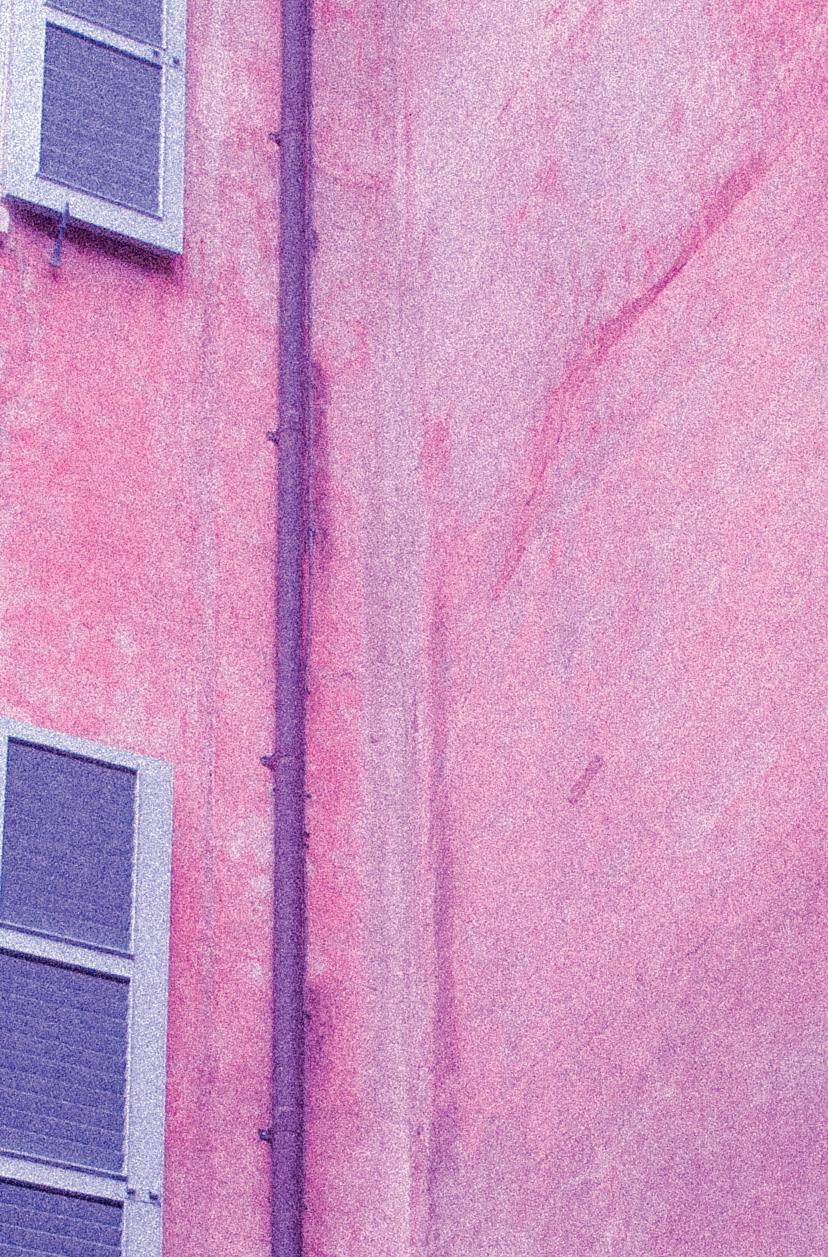

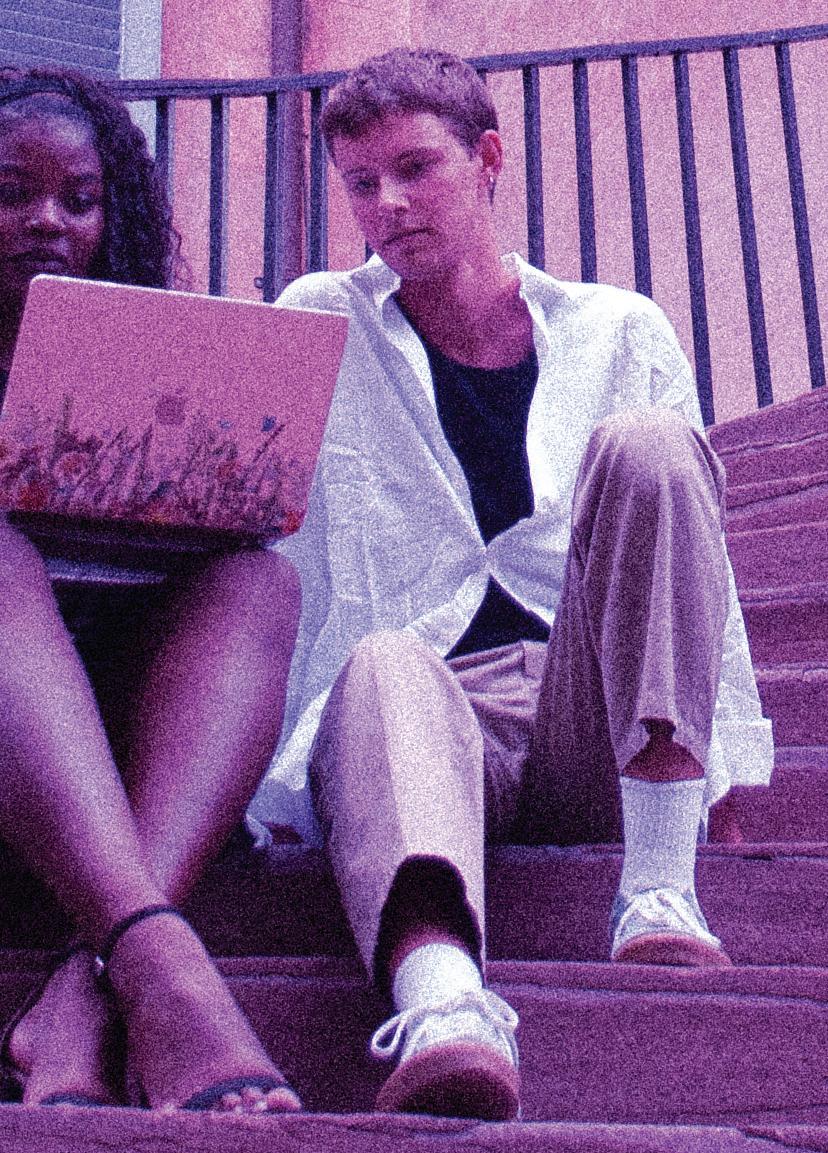















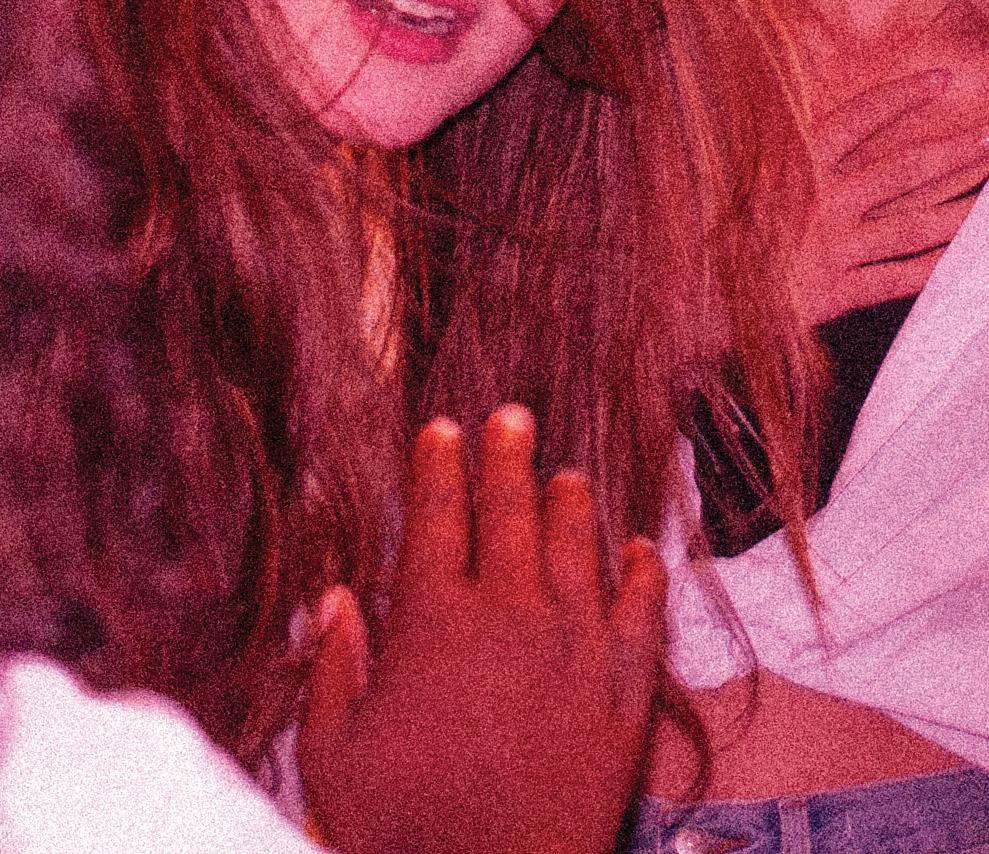

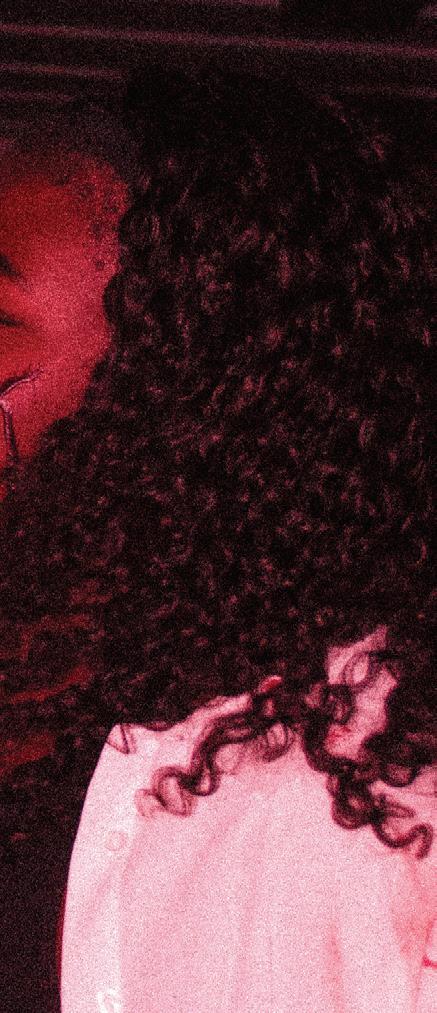
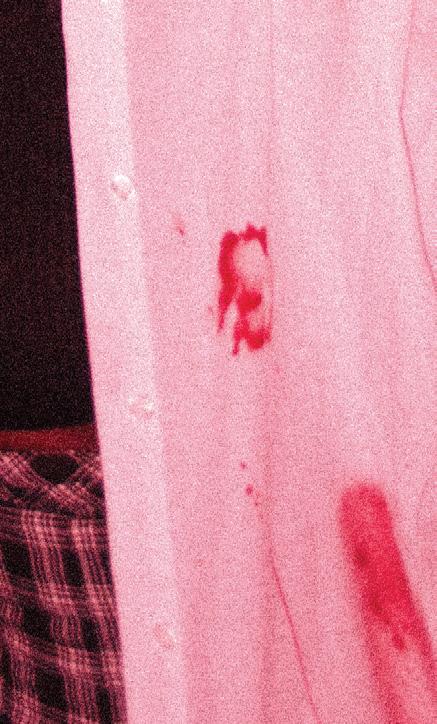
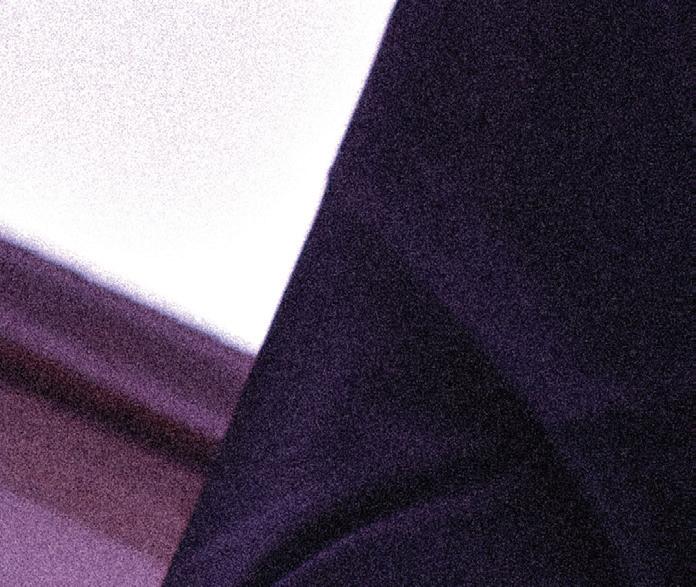



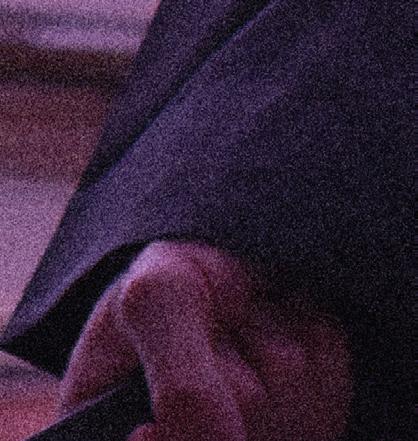








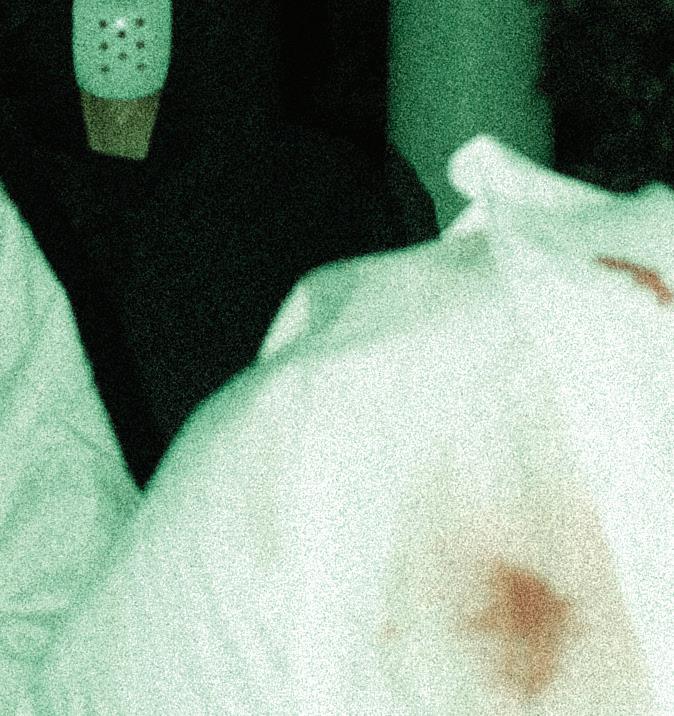






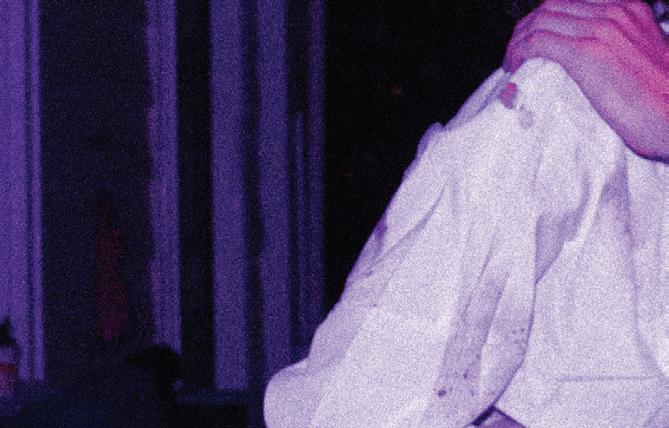




































think back to the weekend before classes started. My roommates and I had nally gotten into our new house, a de nitive upgrade from the dingy apartment we rented the previous year, when we decided to go up stairs and visit with the people living up there. While visit ing, one of the girls who had lived there the year before broke the news to me: our house was haunted, especially my room.
I’m not a superstitious person, but I had to know what ex actly they meant by ‘haunted.’ Did someone get visited by an actual spirit, or was this just a case of cereal boxes getting knocked over in the middle of the night by a draft of wind? ey gave me the number of the person who previously lived in my room, the one who had apparently experienced the most strange occurrences.
I couldn’t resist calling the previous tenant, who I’ll refer to as Jenna. I had very little experience with vengeful spirits, after all, and wanted to know what to do on the o chance I ever encountered one. You can never be too prepared, especially
when you’ve got a ghost in your room.

So, a week or two later I called Jenna. Although I went into the interview with a skeptical mindset, I felt myself listen ing more and more intently to the ghost story that unraveled during our call.
Jenna stated that her experiences began about two years pri or, during the weeks leading up to Halloween. She related her rst encounter to me, where the hand of a small child grabbed her wrist in the middle of the night and yanked on her arm. She dismissed the idea that it was imagined and said that the experience was “not like a dream, it felt very weird”. Despite this, the story still felt dubious at best. Jenna was sleeping when the ghost grabbed her and there were no other witnesses, so I chalked the story up to a vivid nightmare.
After the encounter, Jenna decided to reach out to her room’s previous tenant, who claimed she had also undergone several paranormal experiences and even learned the ghost’s person

ality: a young girl named Minnie. roughout the course of their rst year, Minnie played minor pranks on Jenna and her roommates, but nothing that would suggest an actual paranormal presence. Books were knocked o of walls, lights ickered and ghostly presences were felt–you know, the whole nine yards. Like myself, Jenna stayed skeptical and be lieved her initial encounter was just a bad dream.
Her rst year came to a close and Jenna was still unconvinced her room was haunted, so she decided to stick around. However, staying was a decision she’d come to regret, saying that, in hindsight, “[she] wouldn’t have lived the senior year if the lease didn’t need to be signed so early”.
One night, not long after signing the lease, Jenna awoke in the middle of the night and felt what she described as “a weird urge to go into the living room.” She emerged to nd the kitchen lights on and her roommate, who had been sleeping on the couch, sitting up straight and staring into the kitchen. Jenna asked if every thing was okay and her roommate shook her head. She then asked if they should leave, and her roommate nodded.
Jenna related that “it was 2 am and we had our pillows, and we were wandering the streets, calling all the friends we knew to see if we could crash at their place.” It was there, walking along the streets of Charleston in the middle of the night, that Jenna’s roommate said she saw a dark gure walking in the kitchen, despite everyone else being asleep. It was after this late-night encounter with the mysterious gure in the kitchen, combined with the burning of a protective candle that Jenna believes upset Minnie, when paranormal things really started happening. As Jenna puts it, “that was when all hell broke loose.”
Every night after that, at 3 am, Jenna’s lights would turn on and her fan would turn o . During these experiences, Jenna said that she “would have this strange feeling that [Minnie] was there, watching [her].” She also said that a teddy bear that she kept underneath her bed would end up propped up on her desk every morning. Jenna said that despite the fact that she was a “really, really heavy sleeper” and “never one to wake up in the middle of the night,” she would still nd herself awakening every night at the same time, her lights on, fan o , teddy bear on her desk.
ese experiences prompted Jenna to seek out a spirit medi um to come to the house. Several paranormal experts visited
over the next year to investigate the house, all of whom told shockingly similar stories. According to Jenna, there were very few contradictions in their accounts; they all noticed that my room was the haunted one and pointed out the old replace carved into its wall (pictured on the previous page), saying that it gave them “really bad energy.” ey also all described the same persona– that of a confused little girl searching for her mother.

Interestingly, the mediums said that Minnie wasn’t the only spirit in the house, just the one who connected most closely with Jenna. Upstairs there was a far more malicious entity, that of an adult man. Several suggested that Minnie had been abused and that her vengeful soul still inhabited the room where she was trapped. Jenna said that “the room is very freaky as it is” and pointed out a bolt lock on the outside of the door, which I had thought was simply a normal relic found in old homes like this. at is, until Jenna pointed out that the bolt locked from the outside, as if designed to keep someone in.
All of this being said, Jenna shared the version of Minnie’s sto ry that she and the mediums seemed to agree on. A wealthy family once lived in the house, with the masters residing in the upstairs area and their servant sta sleeping downstairs. Minnie was the daughter of an impoverished servant and lived downstairs with her mother. One of the wealthy men living upstairs would make occasional trips downstairs to abuse Minnie, her mother, or both, resulting in just the kind
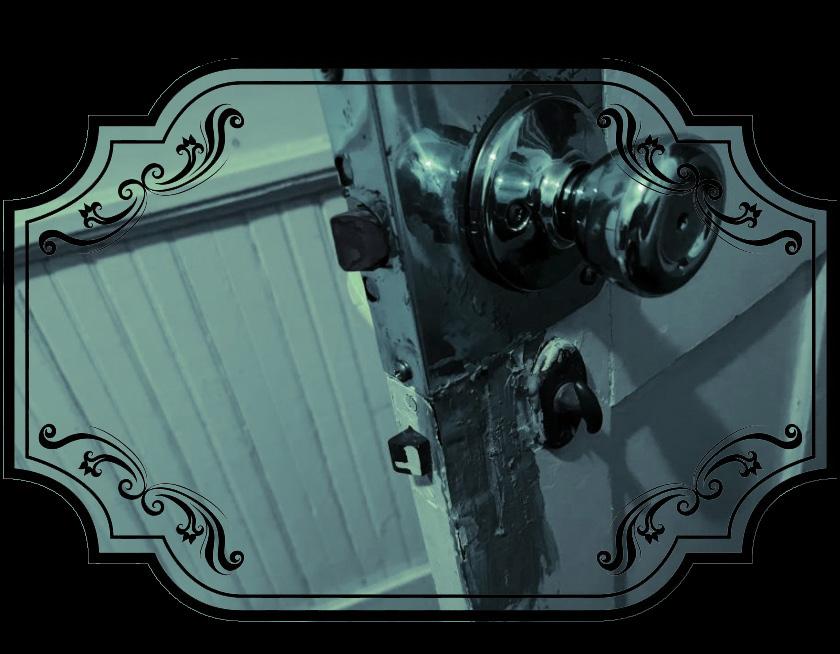
I’ve been living in the house for almost three months at this point and have yet to have any paranormal experiences. Sure, I hear strange bumps in the night, but there’s no way of de termining if they’re the ghost of a little girl coming to haunt me, or just the washing machine upstairs. My lights have ickered on and o before, but faulty wiring is by far the least suspicious thing you’ll nd in an old college house. Jenna said spirits feed o your fear and that she didn’t start having experiences until she validated Minnie and became afraid of her. I’ve remained skeptical of these ghost stories the entire time I’ve lived in the house, so it’s possible I’m not susceptible enough for a spirit to appear to me.
ere’s also the fact that only women have had experiences with Minnie, and that perhaps she doesn’t appear to men be cause of the trauma she went through. So maybe the thing keeping the spirits at bay isn’t my disbelief but rather my gen der. Regardless of the reason, Minnie seems to have mostly left me alone. It feels strange wanting to be haunted, but I’d be lying if I said I wasn’t a little o ended that she hasn’t shown herself to me yet.
Once I had thanked Jenna for the interview and hung up, I looked around my room at all the dirty clothes on my oor and the video game posters on my wall and wondered if this space could really harbor a ghost. Despite my initial disbelief, I found myself a little intimidated after my call with Jenna. After all, I had just spoken with this person who was utterly convinced that the very room I was in was plagued with a
You can call it an actual spirit or just my natural instincts fearing a fantasy, but I won’t deny I felt a shiver sitting there staring at the old replace set into the peeling drywall.
If nothing else, my brush with the paranormal has got me thinking about the power of history. For the rst time since I moved in, I found myself actually thinking about the people who came before me. For hundreds of years, people came home from their daily lives, opened the same door I did each night and drifted o to sleep staring at the very same ceiling as me. In a city like Charleston, it’s easy to get su ocated by how ‘historical’ everything is. Beneath the shade of great oaks stand countless statues of old men who probably did something important once upon a time. ese statues create our idea of the past– a time inhabited by people in strange clothes without a hint of emotion on their stony features. It can be easy to forget that the past was lled with people just like Minnie, people who were just as confused, afraid and in just as much pain as we all are during our darkest hours.
So the next time you see someone hurting, give them a hug. I doubt vengeful spirits are actually real, but just in case they are, let’s all try to avoid creating any more, okay? Otherwise, we’ll all be with Minnie one day, oating around the sub merged ruins of a long-since ooded Charleston, forced to do nothing but brood about how painful our lives were.
And there’s nothing more haunting than that.
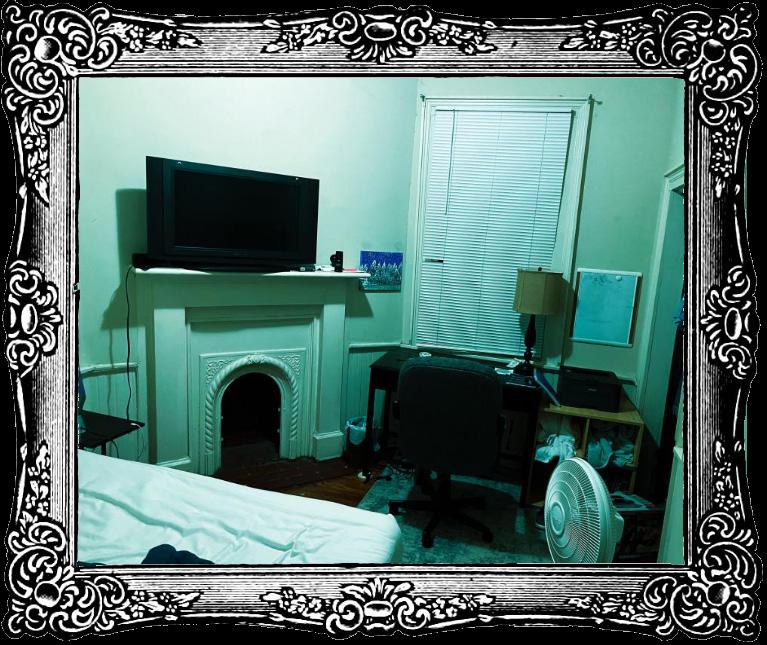

L ooking for some girl power inspiration for the month? Well, here are some of my recommendations to get you feeling like the most powerful version of yourself.
videos to songs like “Run the World (girls)” or “Formation” or “Hold Up,” or watch her Net ix documentary “Homecoming.”
First and foremost, we all need an empowering soundtrack in order to proper ly strut around the town to. So put on your cowgirl boots, and turn on Dirty Computer by Janelle Monae. Trust me, you will im mediately ascend. Janelle Monae is a Black, queer feminist, known for their music, but who also reigns in the eld of acting. eir 2018 album Dirty Computer is a feminist anthem with songs like “Pynk” (feat. Grimes), “Django Jane,” and “Americans” that aren’t shy in their political nature and erce school of thought. With “Screwed,” featuring Zoë Kravitz on vocals o ering a lighter and a more positive approach to songwriting, not only will this album make you feel good, it will help you delve deep er into themes such as Afrofuturism* and intersectionality. So if you feel like learning a little something, with some great beats backing it, the rst place to check out is Dirty Computer.
Some honorable mentions for anthems that you simultaneously enjoy and learn something from: Lemonade by Beyonce is a great one to check out, if you haven’t already. Not only is Lemonade a stunningly beautiful auditory listening experience, it doubles as a visual album with an accompanying documentary. I’d recommend speci cally taking a look at

So you’ve had enough music, and Janelle Monae put you in the perfect mood to get some reading done. Let’s take a look at one of my favorite books with female authors and female leads. An excellent one to begin with is e Seven Husbands of Evelyn Hugo, which tells the story of Cuban bombshell Evelyn Elena Herrera, who is trying to make it big in Hollywood. e novel explores important themes such as sexuality, identity, loss and nally, morals. It gives you all the feels regarding 1950’s Hollywood glamor while providing more substance, allowing you to really connect with the characters. Evelyn Hugo is the de nition of a girlboss and doesn’t let anyone or anything stand in the way of her success. While I personally wouldn’t take after many of her actions, sometimes she can be the hypewoman you need on a day you’re feeling small.
Now that you’ve nished e Seven Husbands of Evelyn Hugo, some other great choices are
Daisy Jones and the Six, Every Last Word, Everything I Never Told You, Somebody’s Daughter, My Year of Rest and Relaxation
and e Invisible Life of Addie LaRue. All of the books listed above are written by female authors, making them the perfect pairing for every other girl power related item in this article.
Now for some ne media. My absolute favorite girl pow er lm, and often my favorite movie in general, is always going to go to Legally Blonde. e reason why it’s one of my favorites has a lot to do with the way it makes me feel, more than the substance. While Legally Blonde isn’t some overtly feminist movie, a lot of its topics and themes come from the foundations of feminism, and it’s a product of “third wave” feminism.
Elle didn’t have to come outright and tell us that she was feminist: her actions did the talking. She treated people with kindness and respect, even when the same wasn’t shown to her. She stood up for herself and refused to change who she truly was to make people like her more. And for a former “CULA Delta Nu” fashion major to make it and thrive in Law school, while staying true to herself, is pretty feminist to me. Additionally, Legally Blonde thankfully doesn’t play into the harmful stereotype of the mean popular girl or dumb blonde, unlike its counterparts such as Mean Girls. Young girls aren’t evil, and de nitely not stupid, which makes me thankful for movies like Legally Blonde that don’t try to make me and others feel like they are.

So if you don’t already believe me, here are a few more rea sons why Legally Blonde is inherently feminist - even before its time:
1. It portrays a strong female lead
2. at strong female lead loves pink and portrays and overt ly feminine woman
3. It portrays that same feminine woman in a strong, pos itive and smart manner as she makes her way through the extremely competitive and often toxic environment that is Harvard Law School.
In the end, Legally Blonde in uenced a generation of women by showing them that law isn’t just men in beige suits. It can be women in sparkly heels and a bombshell blowout, which is why I always come back to it when I need a pick-me-up.
In a world where women are constantly being put down for being true to themselves, media that portrays female leads in a positive light is ever so important. Now I’d encourage everyone reading this article to nd the things that bring them genuine joy, like listed above. And as I like to say, put it in your pocket. So when you have an o day, you can pull out your favorite movie, book or album - and turn your day around.
- a cultural aesthetic that combines science- c tion, history and fantasy to explore the African-American experience and aims to connect those from the Black diaspora with their forgotten African ancestry.
girlpower
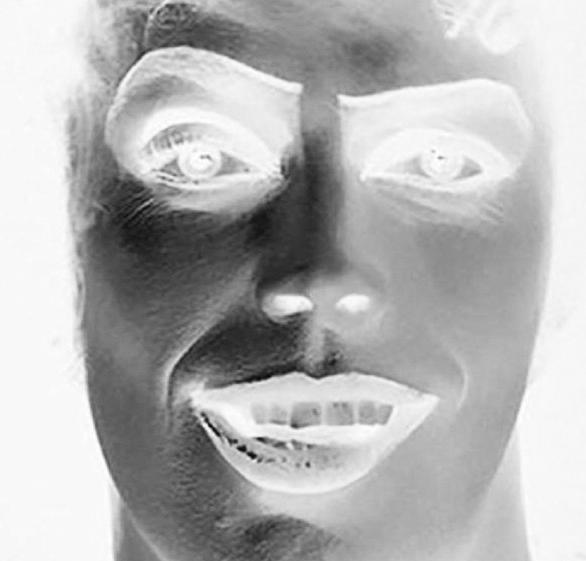
Since its release in 1945, e Rocky Horror Picture Show has become a cult classic and a staple of Halloween tradition for many fans. e plot of this erratic and exotic musical-comedy follows newlyweds Brad and Janet when a storm forces them to take refuge in a castle owned by the very otherworldly Dr. Frank N. Furter. It is then when their innocence and marriage is tested as they meet a cast of wacky and weivrd characters, from punk-rock biker to a creepy butler. e night seems never ending as they meet the mad scientist himself and bear witness to his most magni cent and deadly creation of all.
Even though the lm was considered a box-o ce op upon its initial release, over the past twenty years, it has seen a rise of popularity. e lm most notably has been adapted into midnight movie editions and audience recreations, where audience members reenact the lm in the theater, arriving dressed up in alien makeup and metallic gold shorts. “Shadow cast” performances have also become popular with this show, where the actors act out what is happening while the movie plays behind them and lip-sync along to the characters’ lines that encourages audience participation.
In its current form, the Rocky Horror Picture Show serves as a prime example for embracing the strange and not being afraid to accept the taboo. Fans of the classic love to meet up decked out in costumes and props every Halloween and em brace the weird and wacky that this show represents.

But the question looms in how and why did low-budget lm turn into a yearly extravaganza hat has its viewers dressing up as characters, reciting lines and song lyrics and throwing toast at the screen? When it rst premiered in theaters, audiences thought the movie was too bizarre and tacky, but it seems as
time went on, more and more people seemed to appreciate the camp and absolutely bizarreness of the lm.
Many fans of the lm have shared that the Rocky Horror Picture Show makes them feel heard and feel connected with it. When the movie rst came out in the mid-70s, gender uidity and sexuality were not widely talked about, nor were they portrayed in cinema. People who align with these identities ock to the lm, happy to see themselves being portrayed in public media. e lm also showcased a cast of raunchy, sensual characters who are not afraid to talk about their sexual thoughts and activites. For a lot of people, this lm was a catalyst for sexual liberation and envoked viewers to embrace their desires. It seems that a silly tale about a sensual alien creating his own “perfect man” served as a way of showing viewers that they shouldn’t be afraid to be their true selves.
is witty and sexual musical tale is coming to Charleston Musical Hall for the rst time ever, under the directon of Caroline Magee for Center Stage Productions at the College. Magee says that the Rocky Horror Picture Show is “one of [their] favorite traditions at the College. Not only does it provide a safe space for self-expression and exploration, but it’s also a fun celebration of identity & authenticity. [ ey are] very excited for more people to enjoy it this year.” Be sure to grab your tickets for October 28 for this one-nightonly production. Tickets are ten dollars for non-students, and ve dollars for students (or free for the rst 200 students that reserve their seat). Tickets will be available online at the Charleston Music Hall website or found on the Center Stage Productions Instagram, @ctrstage.
 By Madeline Ritger
By Madeline Ritger
Imagine this: it’s February 1819, you are exhausted from traveling from a town in Georgia. You stop at an inn six miles outside of Charleston and decide to rest for the night, hoping for a bed to sleep in. A beautiful woman who goes by the name Lavinia greets you and informs you that there are no rooms available. She o ers you a warm meal instead, to which you accept. As you sit with Lavinia over dinner, you notice that her husband has been casting you weird glances. Lavinia leaves the room and you swear he is just staring at you. Lavinia comes back in the room with a pot of tea and informs you that she has great news. She tells you that she has had a room open up as she pours you a cup of tea. She tells you that the room is yours, but, as you take a sip of the tea, you notice it tastes weird. Out of sheer politeness, you pretend to drink the strange tea, taking the chance to pour out the contents when the couple isn’t looking while Lavin ia is asking questions. Personal questions, like what do you do for a living, and how much money do you make and do you have a family? You don’t think much of it until you go to your private quarters. You think, why was she asking you these questions? Did she want to rob you? An uncomfortable feeling pools in your belly, and you decide that the armchair by the door is a safer option to sleep in than the bed. You drift o into sleep, and suddenly, you are awoken by a loud bang. You jump straight out of the chair and scan the room, noticing the bed– the very one you were supposed to be in–has somehow slipped through the oor, out of sight. You dash towards the window and jump out, quickly you nd your horse and head into the city of Charleston to nd the author ities. When they ask your name, you announce you are a man by the name of John Peeples and you just survived your own murder.
e Holy City is a place of historic values. It is home to the rst tea garden and golf course in North America, the rst municipal college and even the rst female serial killer. Lavinia Fisher and her husband, John, lived and operated the Six Mile Wayfarer House located right outside of Charleston in the early 1800’s. eir inn operated as a place for travel ers to have a warm meal and a bed to sleep in. Lavinia was described as a beautiful woman with plenty of charm and charisma to make herself well-known in the Charleston com munity. However, that could not stop rumors from the town that began to circulate.
After all, men who stayed at the Six Mile Wayfarer House often turned up missing. Granted, there was not a lot of evidence to support the rumors, but that did not stop locals
was scheduled. Reverend Furman was sent to counsel them, if they so wished. John begged him to save his soul, but Lavinia would not speak with him. On February 18th, 1820, they were brought to the gallows in front of 2,000 Charleston residents. John prayed with the Reverend, who read a letter on the account of John in front of the crowd. In the letter, John begged for forgiveness.
Unlike John, who wanted to leave on peaceful terms, Lavinia showed up in her wedding dress, ghting and screaming the whole way to the gallows. According to the legend, as she was about to be executed, she yelled to the crowd “If you have a message you want to send to hell, give it to me– I’ll carry it.” She then proceeded to jump herself, not waiting on the execu tioner to do the job.

from trying to interfere into why these men were missing. In February of 1819, a group of these locals went to the Fishers, leaving one man to stay with them and keep watch. He was soon attacked by two men and strangled by Lavinia. He man aged to escape. John Peeples would come later that day and also escape an untimely death. John and Lavinia Fisher were then arrested on account of attempted murder.
On investigation, several items that belonged to missing persons were found: secret passages, poisonous tea and false oors. e couple pleaded not guilty, but were forced to stay in the Old Jail until the time of their trial. In May, they were found guilty and sentenced to death by hanging. e cou ple tried to plan an escape using rope to try and drop to the ground. John successfully made it out, but the rope broke, trapping Lavinia. John returned to his cell, unable to leave his wife. In February of the following year, their execution
ere is speculation that the couple is buried in the Unitar ian Church Graveyard, but there is not signi cant evidence to back this up. Local tour guides, however, love this idea. Rumor has it that Lavinia still haunts the streets of Charles ton. Locals have claimed to see her face behind the bars in the cell she was held in at the Old Jail and, later, in the Unitarian cemetery. As you roam the streets this October, keep an eye out for America’s rst female serial killer, because she might have her eye on you…


Ask any Charleston ghost fanatic for the most haunted place in the city, and you’ll get the same answer all around: the Old City Jail. e building itself is enough to strike fear into your heart–from the looming towers to the barred windows to those imposing, cold iron gates. Ghost hunters have come all around to investigate, with the jail even earning a visit from the Internet-famous Shane Madej and Ryan Bergara on Buzzfeed Unsolved. For years, the nighttime tour of the jail was a must for any tourist seeking a thrill, but tours abruptly stopped as the building went under extensive construction. Construction for what, you might ask? To improve the structure so tours can resume more safely? To create a memo rial for all the lives lost there? Nope: the Old City Jail is becoming o ce spaces.
e Charleston County Jail, often referred to as the Old City Jail, was rst built in 1802. It’s suspected that unmarked graves dating all the way back to the late 17th century resided on that land, but no disturbed bodies were reported during construction. e jail remained open for a whopping 137 years, nally ceasing operations in the 1930s. is isn’t the rst time the jail has been placed under construction– after Charles ton’s historic 1886 earthquake, the building was badly damaged, leading to widespread repairs, which included removing the fourth oor. e
jail held numerous big-name inmates, includ ing John and Lavinia Fisher, countless pirates, and Denmark Vesey, who famously planned an uprising against the city in order to free enslaved people in 1821. Around 10,000 (a conservative estimate) people died during the jail’s opera tions, either from execution or disease brought about by the jail’s dank and grimy conditions. When the jail eventually closed in 1939, the property was purchased by the Charleston Housing Authority and remained largely unoc cupied for decades.
at was until the great o ce space renovation began. e Post and Courier rst broke the news of the jail’s potential makeover in 2017, lamenting the possible loss of Charleston’s last endangered landmark. e property was bought by Landmark Enterprises president Jason Ward for a whopping $2 million in late 2016. Ward boasts his plans for creating a rustic workspace, which might be the only word that can de scribe a physically and structurally deteriorat ing building that hasn’t been touched since its decommission in 1939. e Preservation Society estimates that 70% of the stucco throughout the building is cracked. Ward, of course, intends for the aesthetically pleasing bits of history: though they’ll have to cover the pieces of exposed brick in order to prevent the stucco from deteriorat
ing further, Ward assures the Post and Courier that the “stains of age” will remain. Ward intended to keep the building open throughout construc tion. However, try to take a legendary ghost tour of this site, and you’ll nd yourself barred from entry– Bulldog Tours hasn’t o ered any in months.
In 2019, the year Ward initially pro jected to be the wrap of construction, plans were still working their way through the approval process. Internal ly, the jail needs a head-to-toe workup: from rusted iron bars to cracks in granite window sills. When the Post and Courier reached out to Ward in 2019 to inquire when the “restoration” project would be nished (or even be gin), he declined to answer. Construction didn’t o cially begin until August 2021. Over a year later, the face of Charleston’s most historically haunted building is still covered in sca olding. As ghost tours get ready to tackle the Halloween season, it’s unclear when (or if) they’ll ever be allowed to re-en ter the building.
Beyond restoration, Ward has plans to make the 200-year-old jail more corporate-friendly. e only major modern addition to the building will be a staircase and an elevator in the back of the building. Overall, however, the space will be re-equipped in order to hold events, including an outdoor pavilion. So, if you’re looking to host the o ce oyster roast this year, consid er the undeniably most haunted place in the whole city! Ward also reports ‘park-like’ areas, where o ce workers can relax during their lunch break after a long morning of random doors slamming and objects falling o the walls. And don’t worry– there’ll be a co ee shop, too! Hopefully, the noise of beans being ground and milk steaming will cover up the moans and groans of the jail’s original inhabitants.
All jokes aside, there’s a serious question at play here pertaining to the mixture of so-called ‘preservation’


and commercial use. Much of the work done to the jail will indeed preserve the structure for many years to come, which is undoubtedly useful to the city. While much of the city’s historical buildings have been knocked down or repurposed, the Charleston County Jail remains a vital piece of the city’s history that remains standing. But there’s a lot wrapped up in that history– for years, escaped enslaved people were held and brutally tortured here. And sure, it’s fun to think of what souls remain there, but implementing corporate o ces there feels genuinely disrespectful to those people. Not to mention that it’ll undoubtedly bring another wave of gentri cation to Charleston’s already beaten-down Harleston district. Do we really need another co ee shop? Is there not enough o ce space in the greater Charleston area already? While the word ‘preservation’ is being slapped on this project as a means of justi cation, let’s not forget that the main purpose of the project is to turn the jail into something that can be sold. Is this really what we want to become of Charleston’s histor ical spaces? Should someone really be clocking in to their 9 to 5 in a rede signed jail cell where as many as 10,000 people (that we know of) died over the course of 130 years? What’s next– a WeWork space in the middle of the Market? e St. Philip’s Church graveyard as a concert venue? Commercializ ing historical spaces is a slippery slope, and this project is only the beginning.

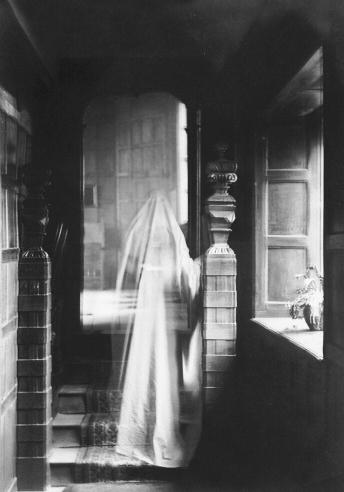


Where the Crawdads Sing is about the abandonment of a young girl Kya, her journey to adulthood and her involvement in the murder of one of her past lovers. The movie has been a sensation since its debut because it explores sensitive topics including rape, feminism and the role of being the “outcast.” The movie grabs the audience’s attention from beginning to end through the complexity of the performances and cinematography. Kya’s performance, as portrayed by Daisy-Edgar Jones, is extremely pas sionate as she embodies what it is like to be an outsider, while representing how women can learn to be strong on their own. Not only is Jones’ acting incredible, but so are the men in Kya’s life. They are able to portray the horrors of abuse and neglect via their acting, since they are the opposition
traumatic experiences in their life. The cinematography is another impactful element of the movie. The cinematographer, Polly Morgan, is able to cap ture the swamp like no other. Polly gives life to the swamp through the still shots she takes of it. In addition, Polly captures Kya in a way that makes
by showing the swamp and the importance it had within the story of Kya’s life. If you are looking for a movie that is heart wrenching, mysterious and watch list.
The Black Phone is a recent horror movie that dropped in theaters and tells the story about a child killer named “The Grabber” and his hostage, Finney. The Grabber, played by Ethan Hawke, has a remarkable performance ing his acting expressions. Thus, the eye contact he maintains is what makes him unsettling and impossible to look away from. Mason Thames’s portrayal a victim of circumstance, he is able to convey the anguish of being abducted. cheap jump scares and predictable events. It will keep you on the edge of your seat throughout, waiting to see what will happen next. If you’re seeking is a must-see.
Elvis Presley is known to this day as the “King of Rock and Roll” and Elvis– he brought Elvis back to life. Butler’s grip on the mic and hip thrust movements during performances made the audience contemplate Elvis’ in Butler’s appearance– from makeup to costumes– made him look exactly like trying to show us what Elvis did, but who he was and where he came from. In a time like now when the world is so divided, it is comforting to look back Elvis grew up in that community, he was exposed to their forms of music, critique that could be seen in Elvis is that no one can ever live up to the leg acy Elvis created. If you are looking for a tear-jerking and passionate movie, Elvis is one to watch.
By: Madison ComoWhen thinking of the college experience, one of the rst things that comes to mind is sweaty frat parties in way-too-small base ments with over-sexed and over-served 18 to 22 year olds. Movies like American Pie and Animal House use this imagery to portray fraternities as organizations that center partying and brotherhood. However, with dozens of fraternities facing accusations of sexual assault and hazing related deaths, the happygo-lucky view of fraternities has changed. Students, parents and academics alike have become increasingly aware of the sometimes problematic behaviors that happen in Greek Life. At the center of controversy in Greek Life, especially fraternities, is the pledging process and hazing.
Before I launch into my discussion of fraternity hazing and its potential e ects, I would like to add a few very important disclaimers. First, I am a part of Greek Life at the College of Charleston and have found my experience incredibly rewarding, although that does not negate the numerous hazing incidents that occur in sororities nation-wide. Furthermore, I am not in a fraternity, so I cannot speak per sonally about members’ experiences. I would like to emphasize that this analysis does not
take into account NPHC organizations or any other ethnic or professional fraternities. Historically Black fraternities have a much di erent history and initiation process, and talking about Black masculinity is a completely separate issue, since the traditional euro-centric patriarchy inherently a ects the portrayal of Black masculinity. Furthermore, I’m white, so it is not my place to speak on the intricacies of NPHC Fraternities and the nuances of Black masculinity and how it a ects the Black com munity. Finally, I am not condemning Greek Life and fraternities, nor is this discussion centered around CofC’s Greek Life or intended to imply that hazing has occurred at CofC, but rather, it is aimed at the broad institutions.
Hazing is a task required for new members of an organization that often is physically de manding and mentally degrading. Hazing does not only happen in fraternities. Sports teams, sororities and other organizations also haze, but the majority of hazing related deaths are connected to frat hazing, which is why they are the focus of my article. Hazing has happened throughout history as a rite of passage to en
sure that members of an organization are dedicated and “strong” enough to join. It establishes a social hierarchy and forces members to comply.
Modern day hazing often includes older members asking the newbies to do their menial tasks, like folding their laundry or picking up cans from a party. But haz ing can be a lot more sinister than that. Often, pledges are forced to drink copious amounts of alcohol and use illicit drugs. Pledges will have to go through intense so cial embarrassment in front of their new peers. Some times, they are forced to endure extreme physical conditions result ing in bodily harm. is happened to Harrison Kowiak, who died in 2008 at the age of 19, when he was tak ing part in a hazing ritual where he was tackled by a man much larger than him in a dark eld. Kowiak is just one of the hundreds of hazing-related deaths in the past century.
Why Hazing?
If hazing is known to be so dangerous, why do many fraternities still do it?
Researchers have found three main motivations behind the perpetuation of hazing rituals in fraternities: pro moting unity, enforcing dominance and hierarchies and teaching skills. Furthermore, we know that hazing kind of works for some of these things. A study by McCreary and Schutts showed that harsher hazing led to higher rates of unity among the groups, and Keating found that men who endured more mental intimidation rated members of the group as more powerful than others,
promoting social dominance. Furthermore, groups with a higher dominance attitude were more likely to defend violent immoral actions against those they perceived as less dominant.
A lot of the hazing rituals seen in fraternities are pledg es trying to prove their strength and masculinity to members– who can withstand the most pain or who can drink the most. Sometimes this process can lead to the acceptance of hypermasculinity, the over-emphasis on certain tradition ally masculine traits: dominance, physicality, ag gression, sexuality and the rejection of femininity. Furthermore, the group culture that the hazing process cultivates forces noncon forming–often less masculine–men to either quit or comply. ose who do not comply will face consequences from the group, which in turn re inforces the toxic, hypermasculine behavior.
e rejection of femininity that is fostered during the pledging process and beyond often results in the rejection of queer ness. Hesp and Brooks found that openly queer men, even those who presented typically masculine, were less likely to become a member than heterosexual men. As a result, members frequently will feel the need to prove their straightness. Casual straight sex is often expected of fraternity members because of the group concensus on ideal masulinity. is idea of perfect masculinity ex tends beyond pledges themselves, a ecting women who are the subject of the pressure to engage in heterosexual
Furthermore, the group culture that the hazing process cultivates forces nonconforming –often less masculine–men to eitherQUIT OR COMPLY.QUIT OR COMPLY.
sex.
When sending their children o to school, guardians often warn about the dangers of college. With women and femme presenting people, the warnings often include these com mands: never walk alone at night, cover your drink, be careful who you drink around and so on. Sexual assault is so prevalent in college that wom en are tought how to avoid it, but often, this isn’t enough. Women are disproportion ately more likely to be the victims of sexual assault, and moreover, men are often the perpetrators.
According to research by Courtney A. Franklin and her colleagues, men in fraternities were much more likely to report that they had participated in an instance of sexual assault and were more likely to have this behavior rein forced by their peers. Additionally, fraternity members reported higher rates of alcohol and drug consumption, which both directly correlated to sexual assault. is is not tied to individuals’ toxic beliefs of masculinity, but rather a group acceptance of these ideas. Just like haz ing is driven by groupthink, attitudes towards outside groups are too.
e acceptance of hypermasculinity and the deep group unity fostered during the pledging process and beyond allows for the continuation of rape culture. is is especially true when it comes to how hypermasculinity a ects the meaning of consent. A study found that men in fraternities were more likely to have purposefully gotten a woman intoxicated to have sex. Furthermore, women who were intoxicated or that dressed and looked a certain way were seen as “targets” of sexual advances. e perpetuation of social hierar chies promoted during hazing seems to relate to this. If violent hazing can be justi ed by asserting separate rungs on the social ladder, then rape could be, too.
We should all care about fraternity hazing. Not only does the process result in abuse towards young men phys ically and men tally, sometimes even resulting in death, but it also contributes to the further subjugation of women and queer people. If we want to reduce the prevalence of hazing related deaths and sexual violence on college campuses, we need to take a harsher stance against hazing and its preservation of toxic masculinity.
Women are disproportionately more likely to be the victims of sexual assault, and moreover, men are often the perpetratorsthe perpetrators
It feels like high school was only yesterday; now, here you are, about to cross the bridge, not into the afterlife, though it may feel like it. But rather crossing the bridge into adulthood. Hoping maybe one of your many in ternships might progress into something more, all while struggling to juggle school as well as any other responsibility you hold and, worse, having to answer the constant question of what’s next. Call it sentimental, but the end of my undergraduate schooling being near leaves me, in a way feeling lost, maybe like soon I will be missing a piece of me. Wanting to know what next but knowing only you can answer that question.

Yet, at the same time, another very di erent part of me can’t wait to get that diploma in hand and run to the nearest exit. I can only imagine this is a feeling we all feel.
As a senior, I feel as if my view is much di erent than when I started college. As a transfer student from a two-year program, I’m sure there are dif ferences in how I rst view the college versus those in my class that has been here all four years.
But vividly, I remember feeling so young and nervous, carrying a heavy backpack lled with items I probably will never use. Holding a print ed-out copy of a map of the campus, highlighted to ensure I could get around precisely and as quickly as possible, pep-talking myself to be more con dent and open than high school and make connections because these could be forever. No, these will be forever.
inking back, perhaps I put so much pressure on myself but regard less, I can proudly say I have become more mature with time almost naturally. Maybe that’s just growing up, but I would like to think the college experience helped too.
Sometimes I like to help and guide those underclassmen younger than me because it would have been nice if I had someone like that when I started. at’s just mom-friend mentality, I suppose.
It’s funny to think how di erent you can become in just four years; whoever said every ten years lied.
Every week I feel like I hear new changes coming to the college “did you know the dorms are being renovated” or “do you know we have 3D print ers on campus?” Granted, seniors like me won’t reap any bene ts of future changes, but something about this change going on around me makes me think about where the time has gone.
Not to sound like a downer, because even with the confusion and the sadness, I love being a senior. ere’s something about being the oldest in a setting that makes you feel like someone people can turn to. But being a senior, I don’t often have to be on campus as frequently as I used to, so it feels often like I’m out of touch on campus. O -campus living is always di cult. Often little is heard about us, but I digress. I can’t explain what drove me to write this piece is to let those in a similar position as me understand that though it’s scary, you are not alone, and this next big step you take, someone will be there, I guarantee.
 By Lara Odell
By Lara Odell
Being a part of Gen Z gives us all a natural inclination to relive our childhood in whatever way we can. is longing for a childhood whimsy felt during the holidays returns each year when our society covers reality in festive pajamas, pungently scented candles, and glittery decor. No one knows why our generation is so obsessed with nostalgia, but we are, and capi talism has a eld day with it year after year.
As Halloween season creeps in this year, so does a Disney reboot from 1993, Hocus Pocus. Although the original Hocus Pocus was a little before our time, the HauntoberFest of the early 2000s made sure young Gen Z kids were well accus tomed to important Halloween originals; think Halloween town, Twitches, and e Little Vampire.


A little less than two decades later, Disney pulled us back into their holiday trap with a Hocus Pocus sequel. Yes, they’re bringing back the three witchy sisters from Salem, the talking black cat, and dance party curses. So obviously, I had to tune in to see if the magic of this movie was really in Sarah Jessica Parker’sParker’s magical portrayal of the dumb blonde witch or if we were just jaded children hypnotized by the costumes and movie magic, or both.
What a perfect excuse to relive times when we were small on our parents’ couch surrounded by crumpled candy wrappers and staring up at the glowing TV screen. e night of the Hocus Pocus 2 premiere, I did just that. And I have to say, this sequel may become a new Halloween Disney channel classic. It has the perfect amount of nostalgia from the Sanderson sisters, the right amount of current cultural references, and the main characters are women. If you’re searching for an uplift ing Halloween lm to tune in to this season, this one won’t disappoint.



